Venues
MUSIC HALL
a.k.a Schneiderman’s Music Hall
413 or 413½ S.W. Tenth
most advertisements and mentions state SW 10th and Stark
Background and research. Building: built unknown.
Per City of Portland Directory, page 2281, 1940 – Music Hall 413 SW 10th Ave.Building had various addresses.
First business found was Club Victor.
415 SW 10th
Club Victor 193? -
Bal Tabarin September 25, 1936 [page 14 Club Victor became Bal Tabarin] until 1937 – no further mention in paper
Music Hall 1939-1950 [1939 took over Club Victor/Bal Tabarin location at 415 SW 10th.
Terrace 1951 [planned, never opened]
Building torn down around 1961 with a new building “415” or the Checkboard Building built in 1962.
413 SW Tenth OR 413 ½ SW Tenth
The Music Hall aka Schneiderman’s Music Hall originally moved to 415 SW 10th 1936-1939
Zebra Room then took over the Music Hall storefront location in 1939
Backstage – unknown location possibly entrance on 11th – there is only one mention in press and that is the sale of stock.
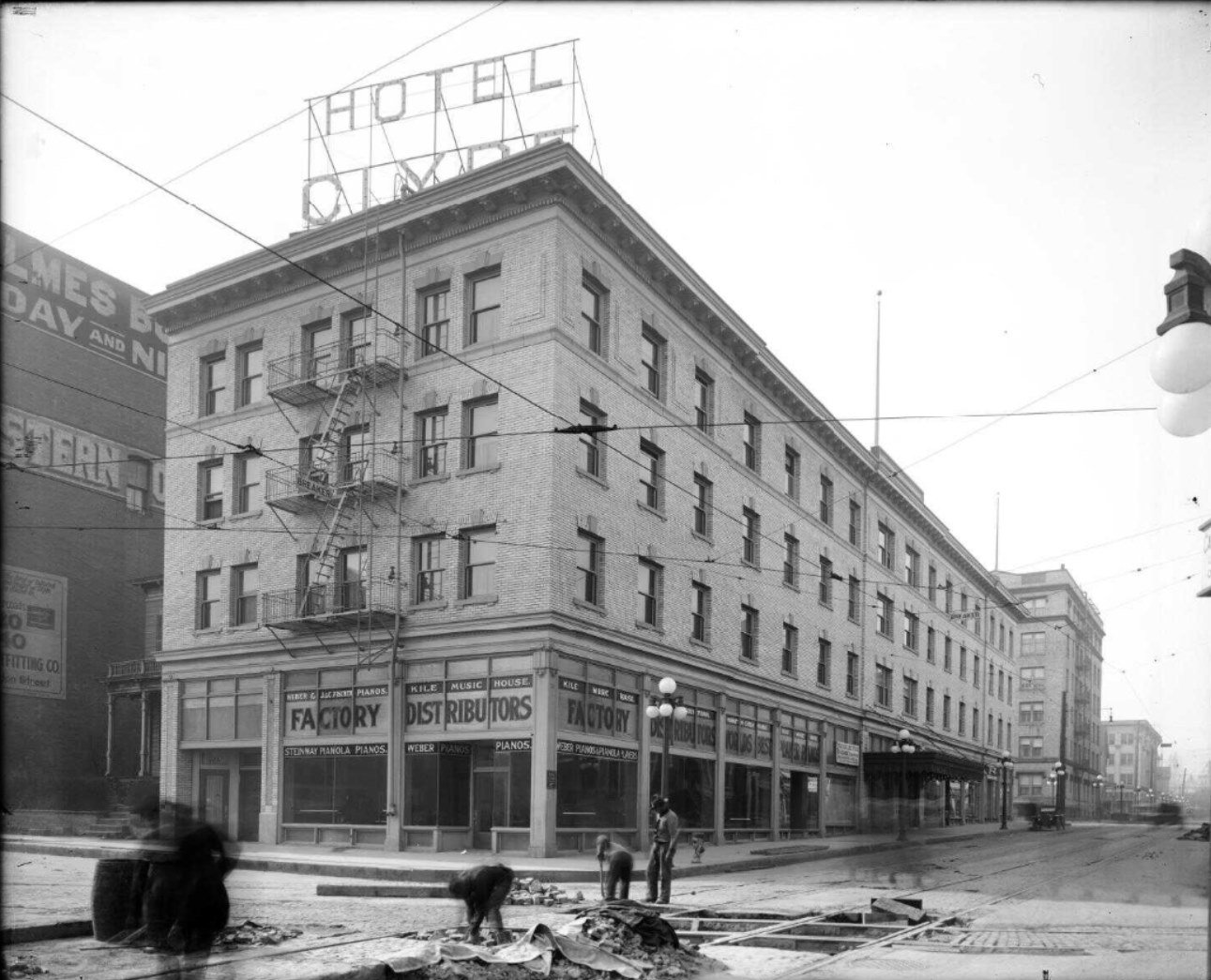
Originally, there was no ‘building’ but a house between two buildings as shows in an early photo
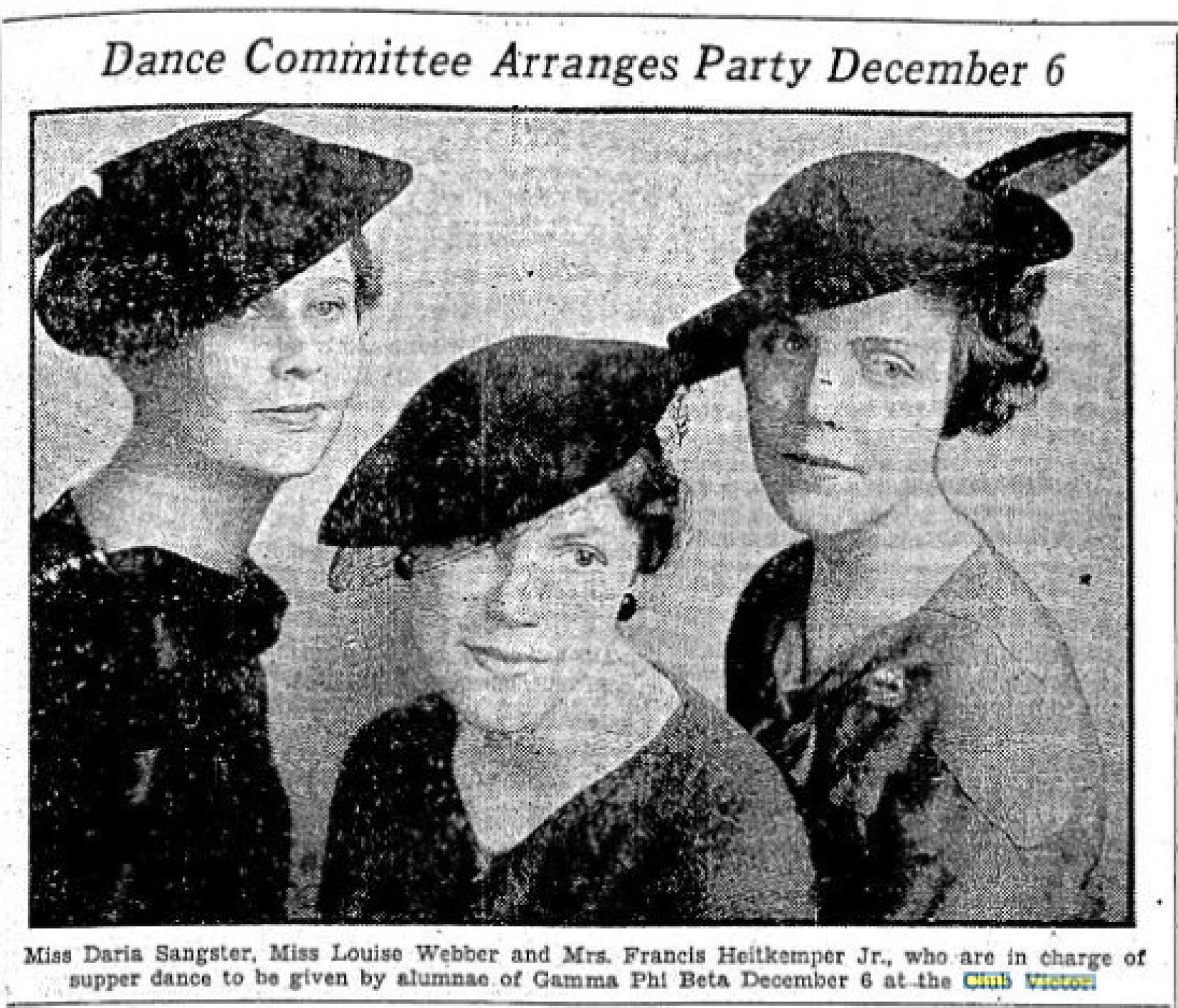
First business believed to be The Club Victor held many social events such as a party on December 6th per the Oregonian, December 2, 1934, Page 29.

Society news for Club Victor where an Annual Charity Ball was to be held, Oregon Journal December 22, 1935, page 28

Here is an article in the Oregon Journal February 21, 1936, page 5, “Club Victor announces new policy”.

Society news continued as with this article in the Oregon Journal February 16, 1936, page 32.

Then things changed per ad in the Oregon Journal February 21, 1936, page 2
![No sooner had Club Victor announced in their ad No Cover charge, per the below article in Oregon Journal September 25, 1936, page 14 Club Victor became Bal Tabarin! [Note there was another Bal Tabarin in San Francisco at this time]](https://images.squarespace-cdn.com/content/v1/6324fa1d5d2c5f1d7acfce0f/e4409837-4dc2-43c4-927c-364a30f30daf/All+Venues_Page_005_Image_0001.jpg)
No sooner had Club Victor announced in their ad No Cover charge, per the below article in Oregon Journal September 25, 1936, page 14 Club Victor became Bal Tabarin! [Note there was another Bal Tabarin in San Francisco at this time]

Then by October 1936 Oregon Journal October 1, 1936, page 20 – with an ad.
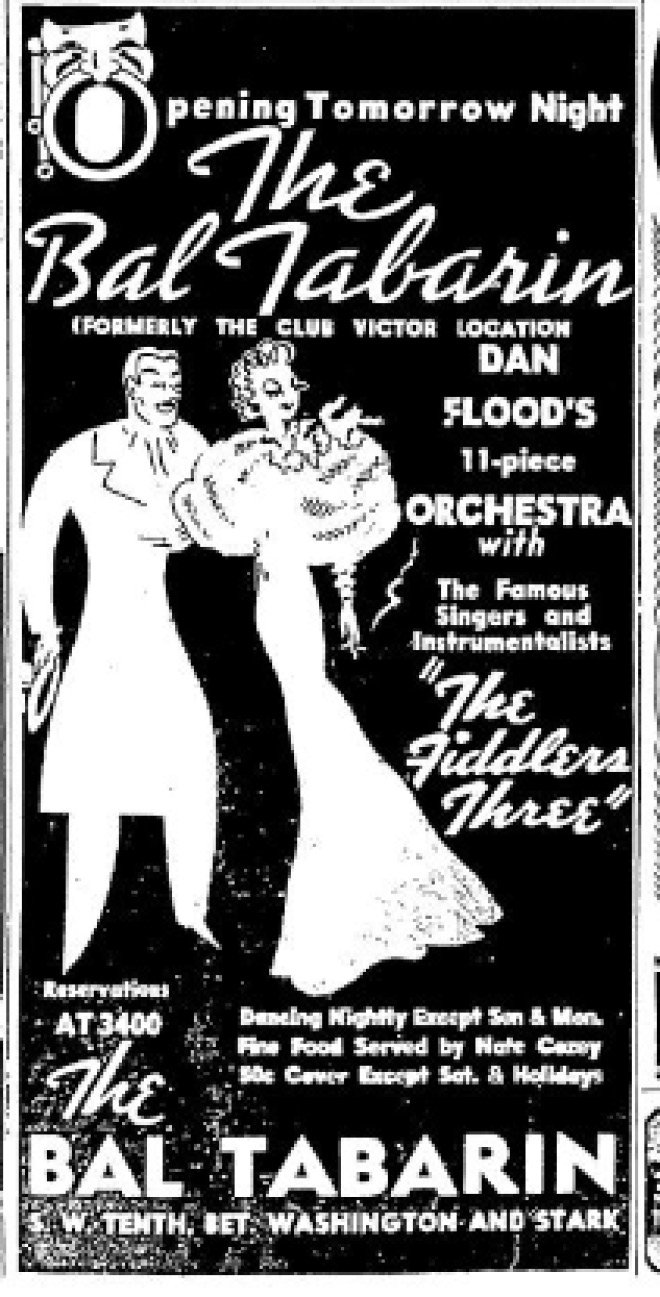
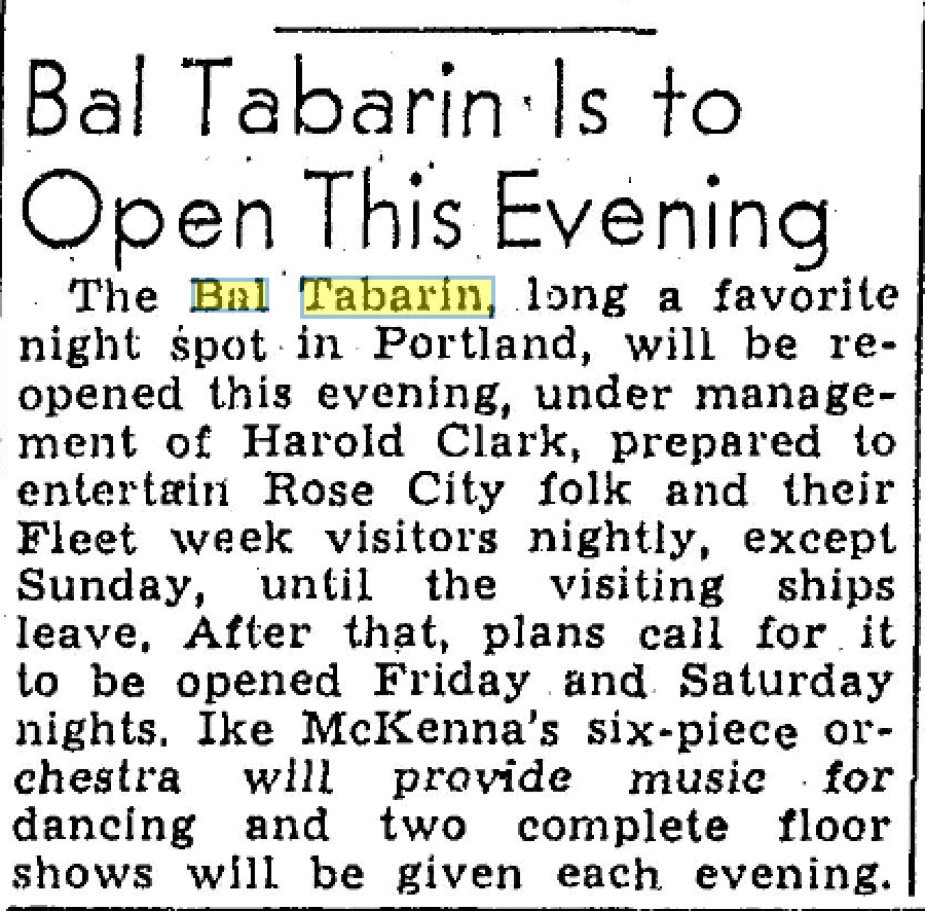
During this time, the Bal Tabarin received a lot of press notices when in 1937 it went under new management per article in Oregon Journal July 16, 1937, page 10.
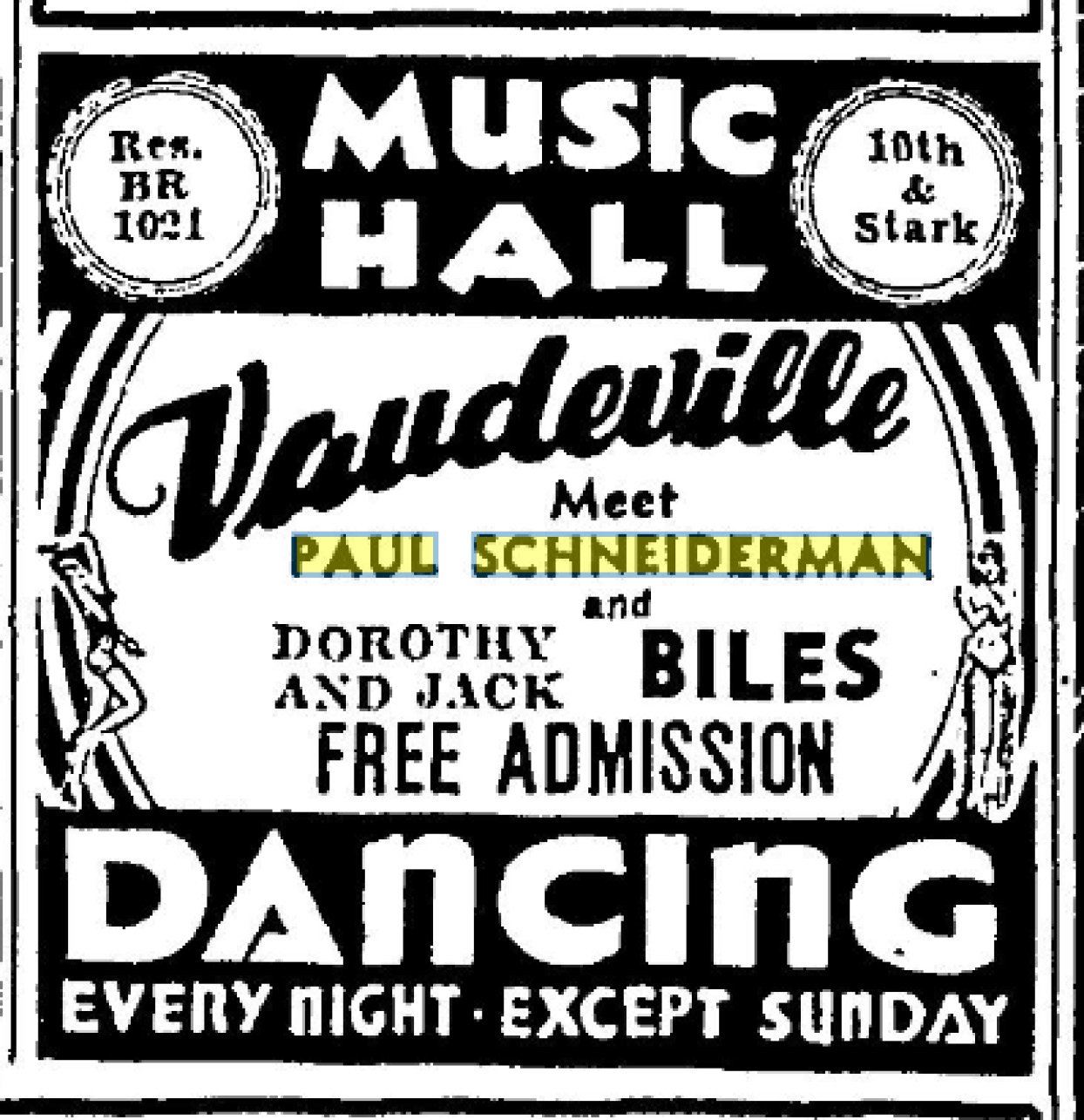
It appears that Paul Schneiderman Russian Jewish emigrant took over a space in the building where Club Victor was, presumably on the main/street level and opened the Music Hall, what appears to be with the announcement in the first ad that appeared in the Oregon Journal September 18, 1936, on page 23, where the Music Hall has “Vaudeville”.

Then, within six months, Paul, the owner runs into troubles with the OLCC: Music Hall was cited in 1937 per Oregonian article about OLCC licensing, Oregonian January 30, 1937, page 22.
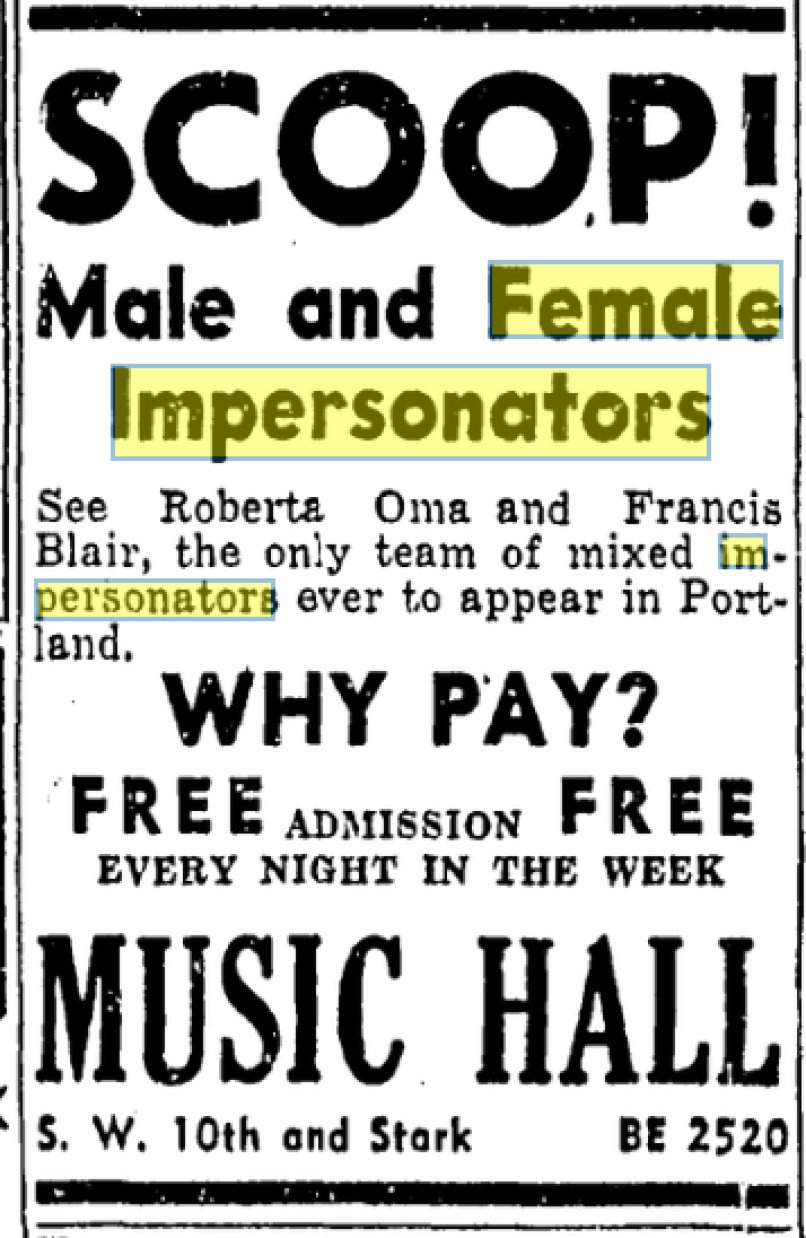
There are various ads in the papers, but by 1938 ads for female impersonators started appearing. January 28, 1938, Oregon Daily Journal – Portland, OR notice the Music Hall NOW has Female Impersonators on the bill – Francis Blair was a Seattle born entertainer who worked for years at the Seattle’s The Garden of Allah which is believed to be the first gay owned bar in the US. It ran from 1946-1956. [Book entitled An Evening at the Garden of Allah: A Gay Cabaret in Seattle by Don Paulson with Roger Simpson.] Francis was one of the first performers to join the Garden of Allah in 1946. Syndicated columnist Walter Winchell wrote about Francis as ‘the boy with the million-dollar legs.” She was known for her singing, but also danced, stripped, produced shows and designed costumes. During the Korean War, Francis did shows for the United Service Organizations (USO) which provided entertainment for the US Military. A rather prim hostess of the show had a fit when Francis stripped down to only a G-string. [https://zagria.blogspot.com/2018/08/francis-blair-1913-performer.html]
![Look at Variety Hall which was located in the Oregon Hotel [later to be torn down and replaced with a building known as the Benson Annex] and Music Hall were vying for the same audience – using female impersonators. So, with this article, it appears](https://images.squarespace-cdn.com/content/v1/6324fa1d5d2c5f1d7acfce0f/b2d45bc9-82b8-4b9a-bdff-0743f7a90e33/All+Venues_Page_008_Image_0002.jpg)
Look at Variety Hall which was located in the Oregon Hotel [later to be torn down and replaced with a building known as the Benson Annex] and Music Hall were vying for the same audience – using female impersonators. So, with this article, it appears that this is when female impersonators were introduced at the Music Hall. Another ad, Feb 4, 1938, Oregon Daily Journal (Portland OR)
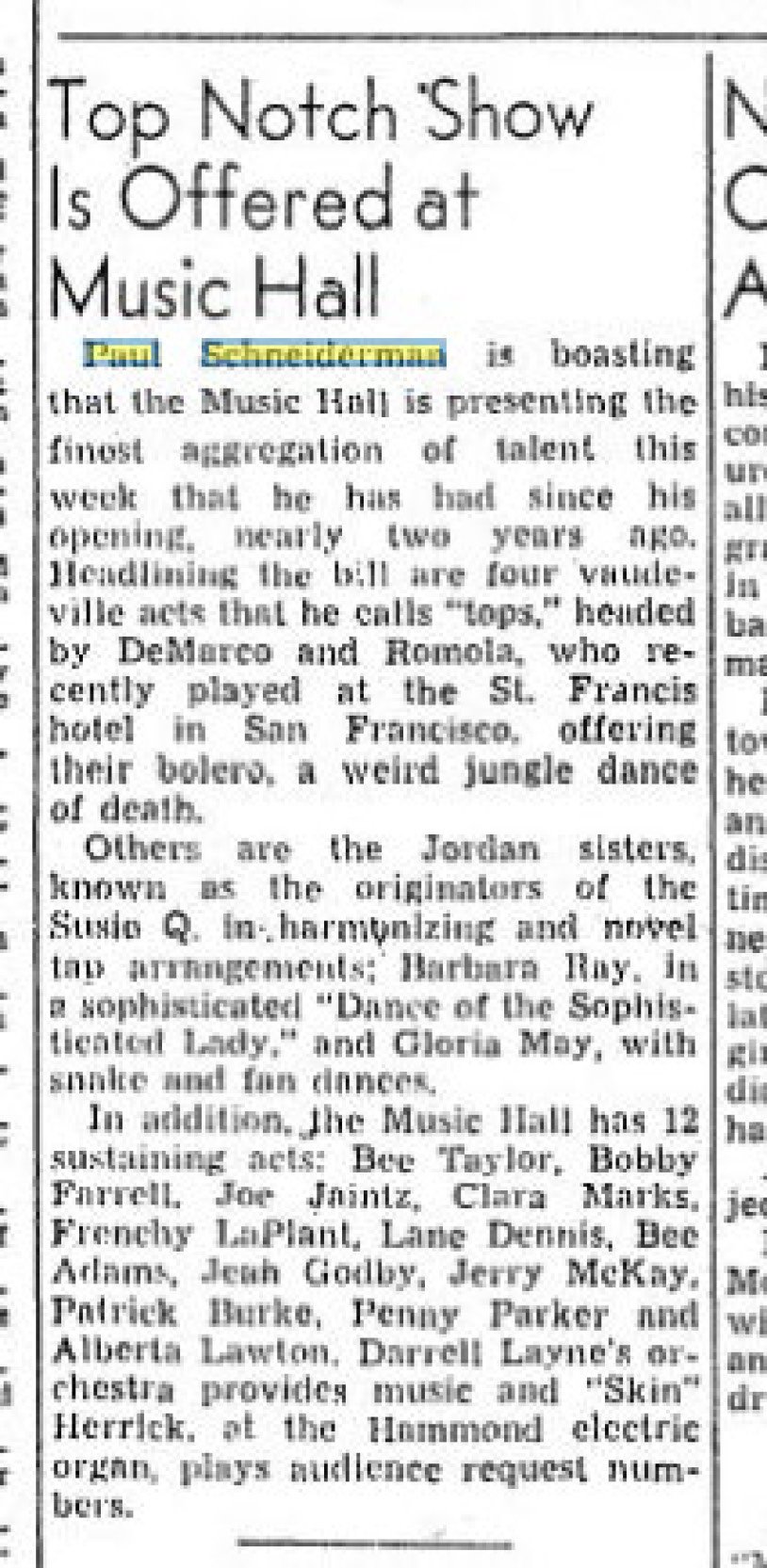
By April though an article is written in the Oregon Journal April 15, 1938, page 10 and it doesn’t mention any female impersonators. It does state, ‘opened nearly two years ago’ .
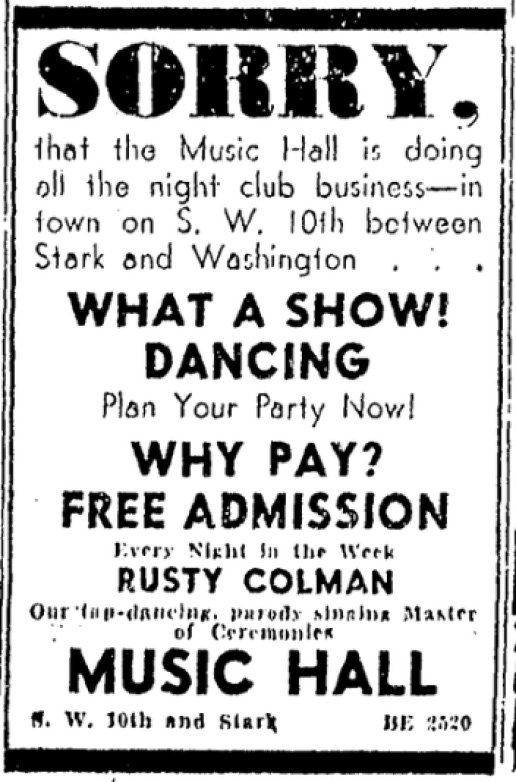
Then with the May 13, 1938, Oregon Daily Journal (Portland OR) ad, it doesn’t mention female impersonators in its ad, Music Hall even though two months before did – doesn’t. Should be noted, that the Variety Hall continued to mention that they had female impersonators. So, what happened? It appears that the Music Hall had female for January 1938 until April? But, in July, per the following article in the Oregon Journal July 16, 1938, page 2 article it states, “including female impersonators...”
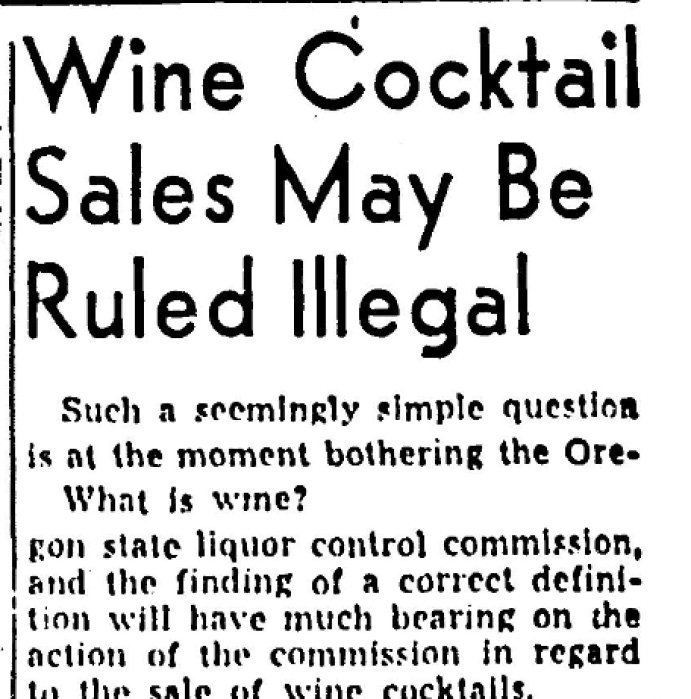
It seems Paul was ‘answering’ the City of Portland and the OLCC’s ‘attack' because he took out an ad on Oregon Journal, August 3, 1938, page 6
![By August [the article August 24, 1938, Oregon Daily Journal], the announcement ‘Danny Brown’s “Female Impersonators”. Danny Brown was the Co-Creator and Co-Director along with Doc Brenner of The Jewel Box Revue which began in 1932 in Youngstown, Ohi](https://images.squarespace-cdn.com/content/v1/6324fa1d5d2c5f1d7acfce0f/fef72d7b-2833-424a-93c5-32fc436b30f7/All+Venues_Page_010_Image_0002.jpg)
By August [the article August 24, 1938, Oregon Daily Journal], the announcement ‘Danny Brown’s “Female Impersonators”. Danny Brown was the Co-Creator and Co-Director along with Doc Brenner of The Jewel Box Revue which began in 1932 in Youngstown, Ohio.
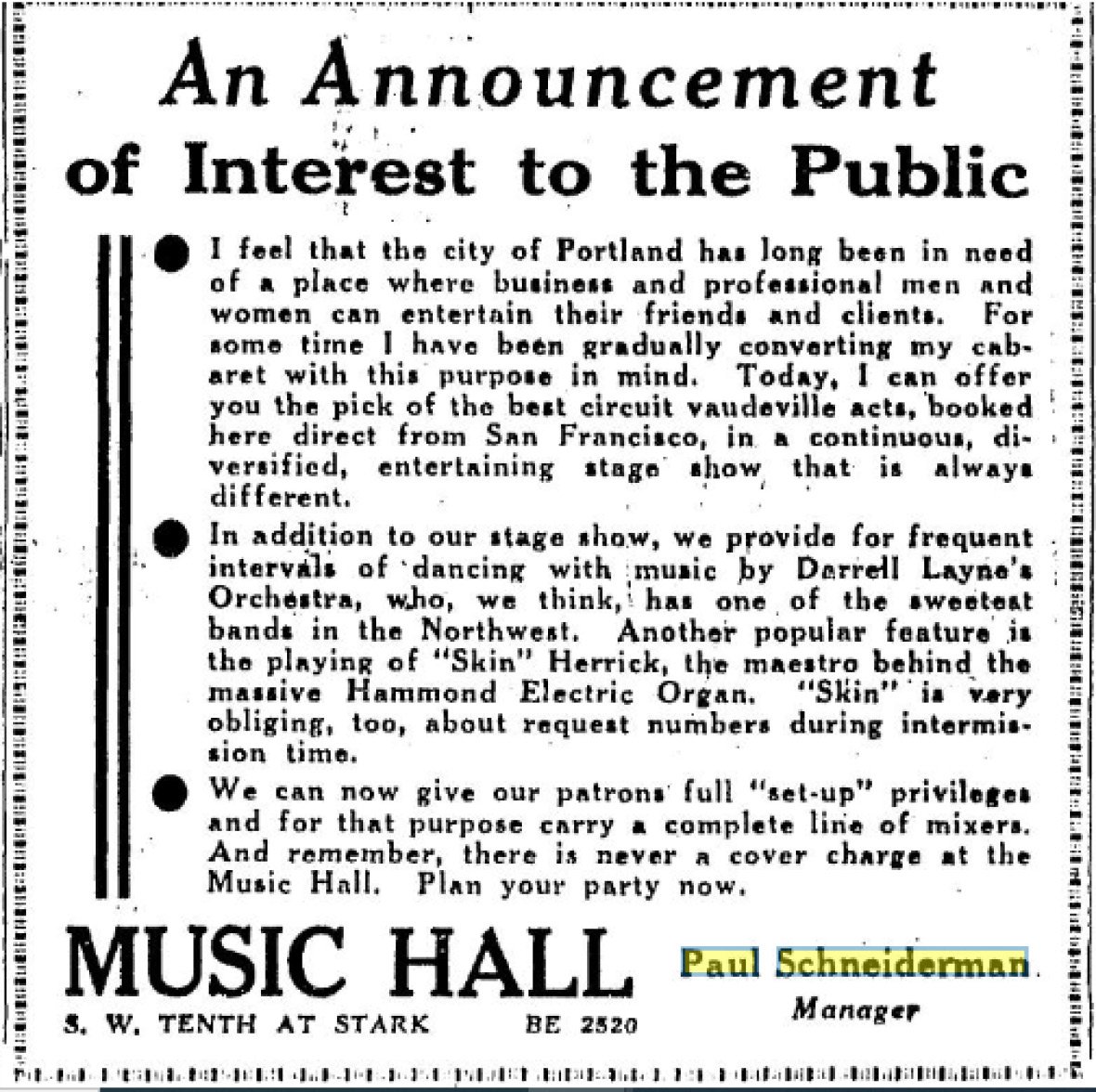

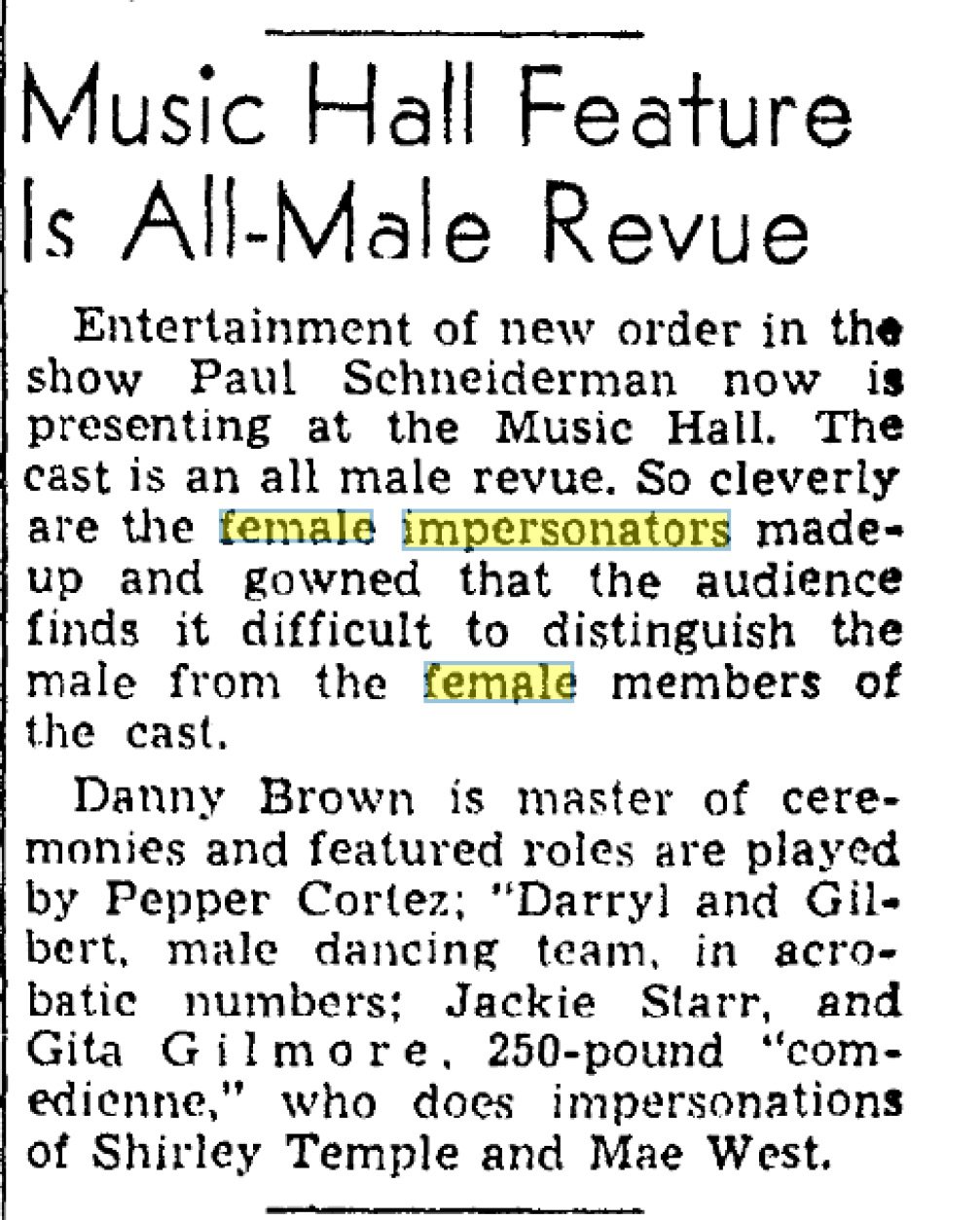
Appears that Danny Brown stayed in Portland for a short time as the MC per the article in the August 27, 1938, Oregon Daily Journal.
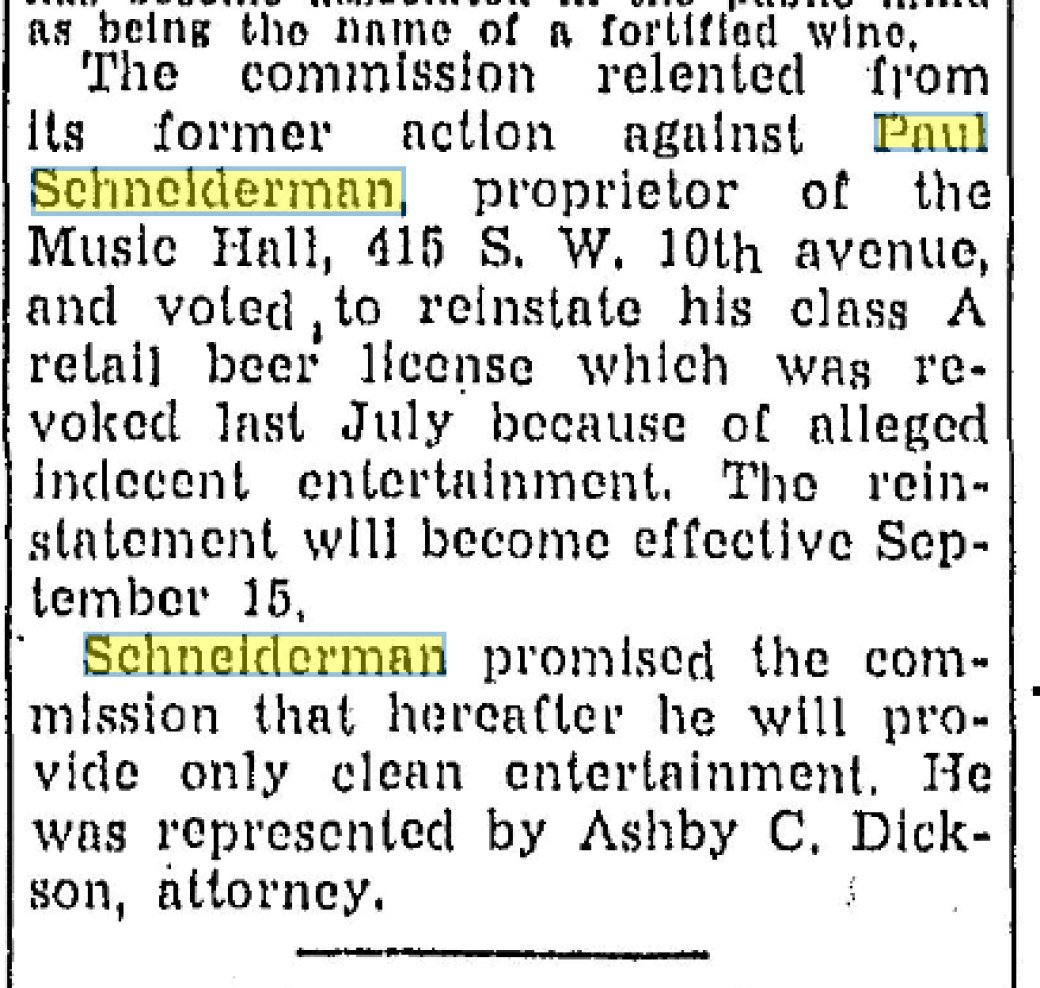
Interesting that per an article in the Oregon Journal September 10, 1938, page 10, the OLCC grants the Music Hall a liquor license and Paul promises to ‘provide only clean entertainment.’
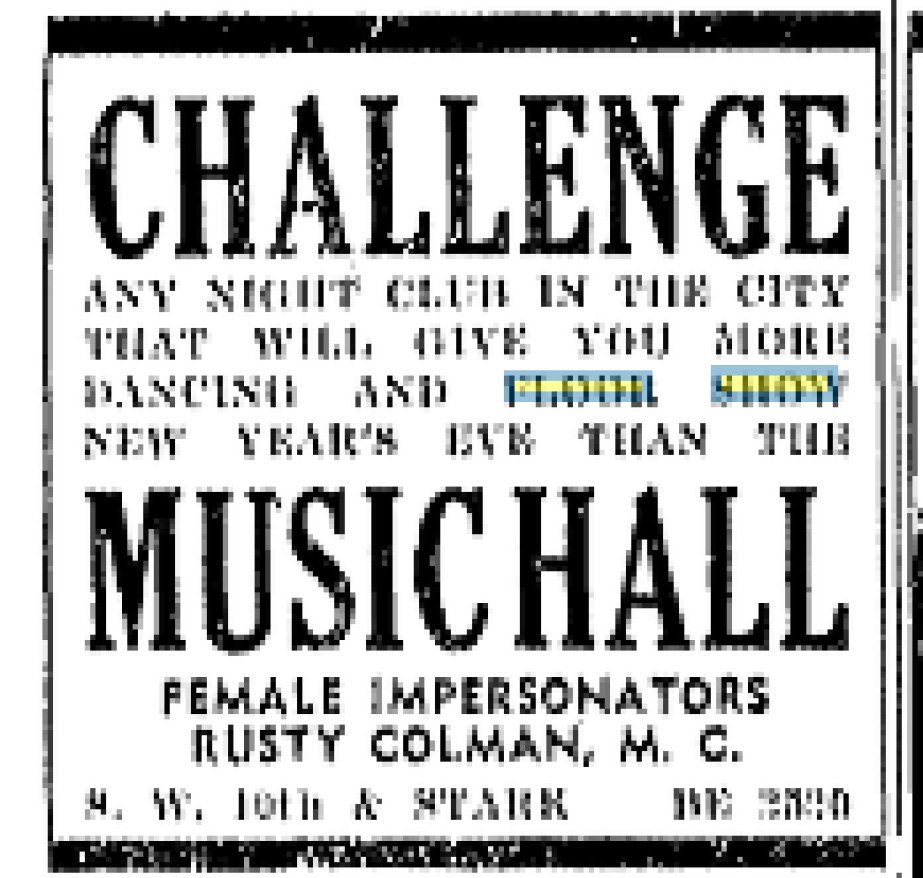
By December 30, 1938, the ads in the Oregon Daily Journal read, FEMALE IMPERSONATORS as the attraction. Was Paul’s September ‘clean entertainment’ female impersonators?

Then Paul sought another liquor license per the Oregonian, June 9, 1939, page 13 – this would take over the Club Victor/Bal Tabarin space which appears to have been upstairs.

By June 15, per Oregonian June 15, 1939, page 12, the Music Hall moved to 413 ½ and SW 10th – taking over the space of Club Victor/Bal Tabarin space – larger space.
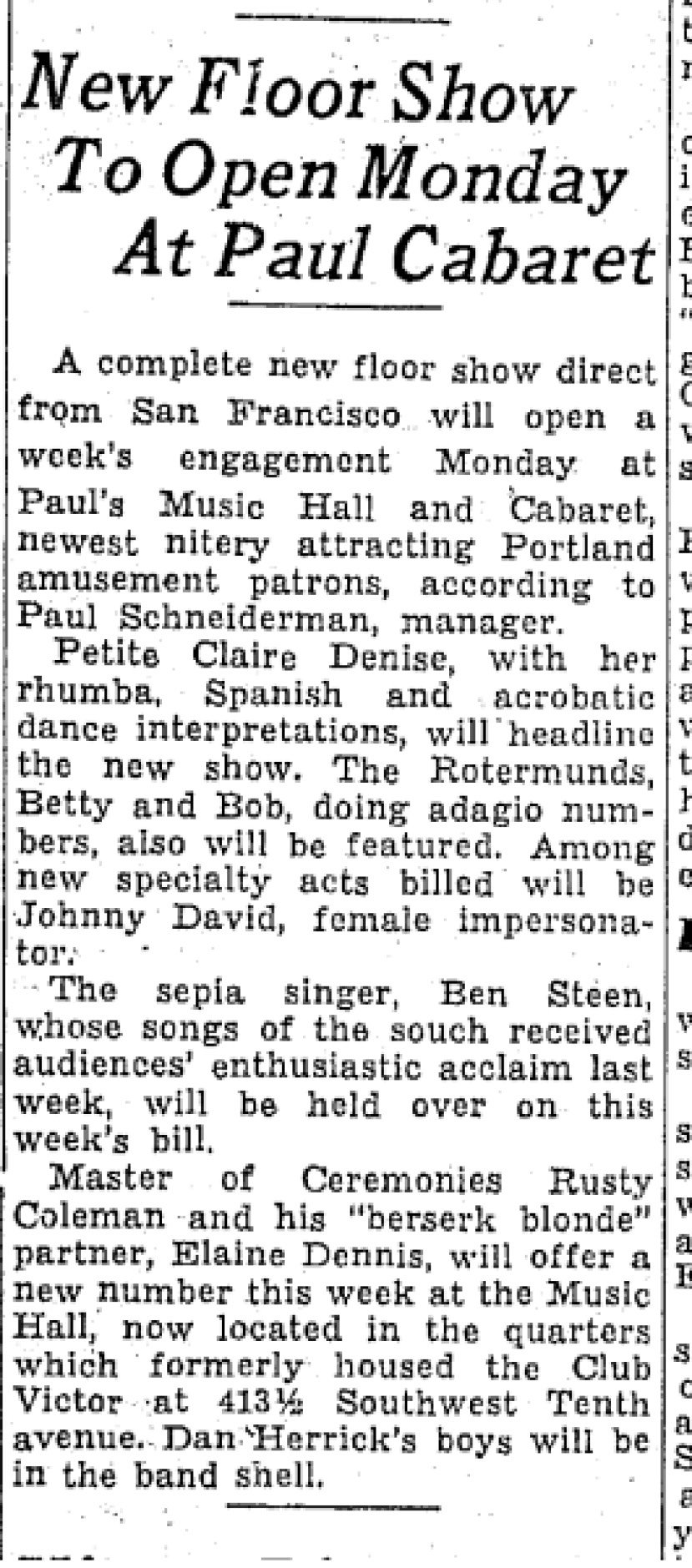
The Music Hall received another article June 25, 1939, page 37
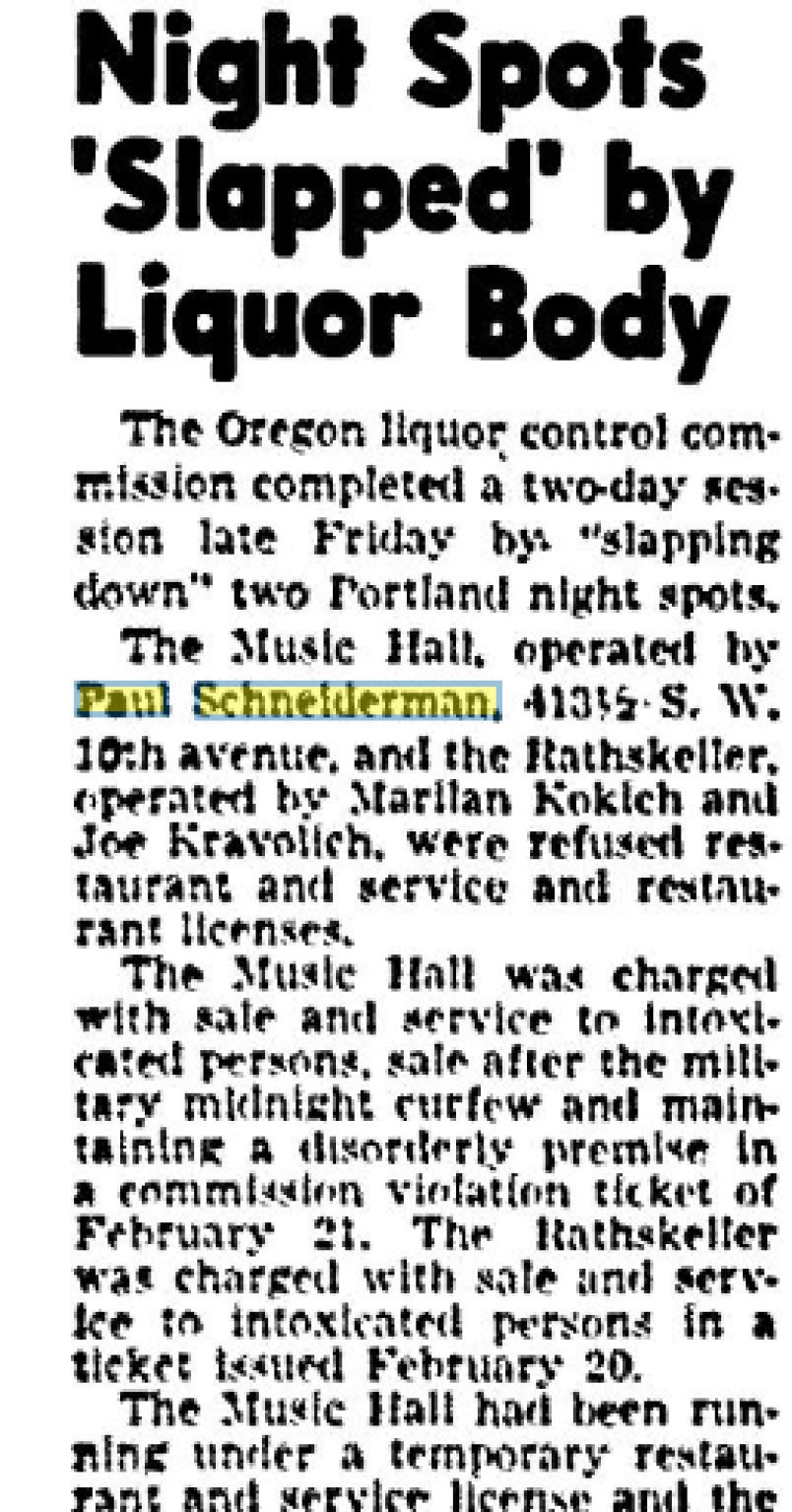
Between 1939-1943 the entertainment cited in papers and ads did not include female impersonators. However, in 1943, Oregon Journal, March 20, 1943, page 3 the OLCC refused restaurant and service license along with The Rathskeller.
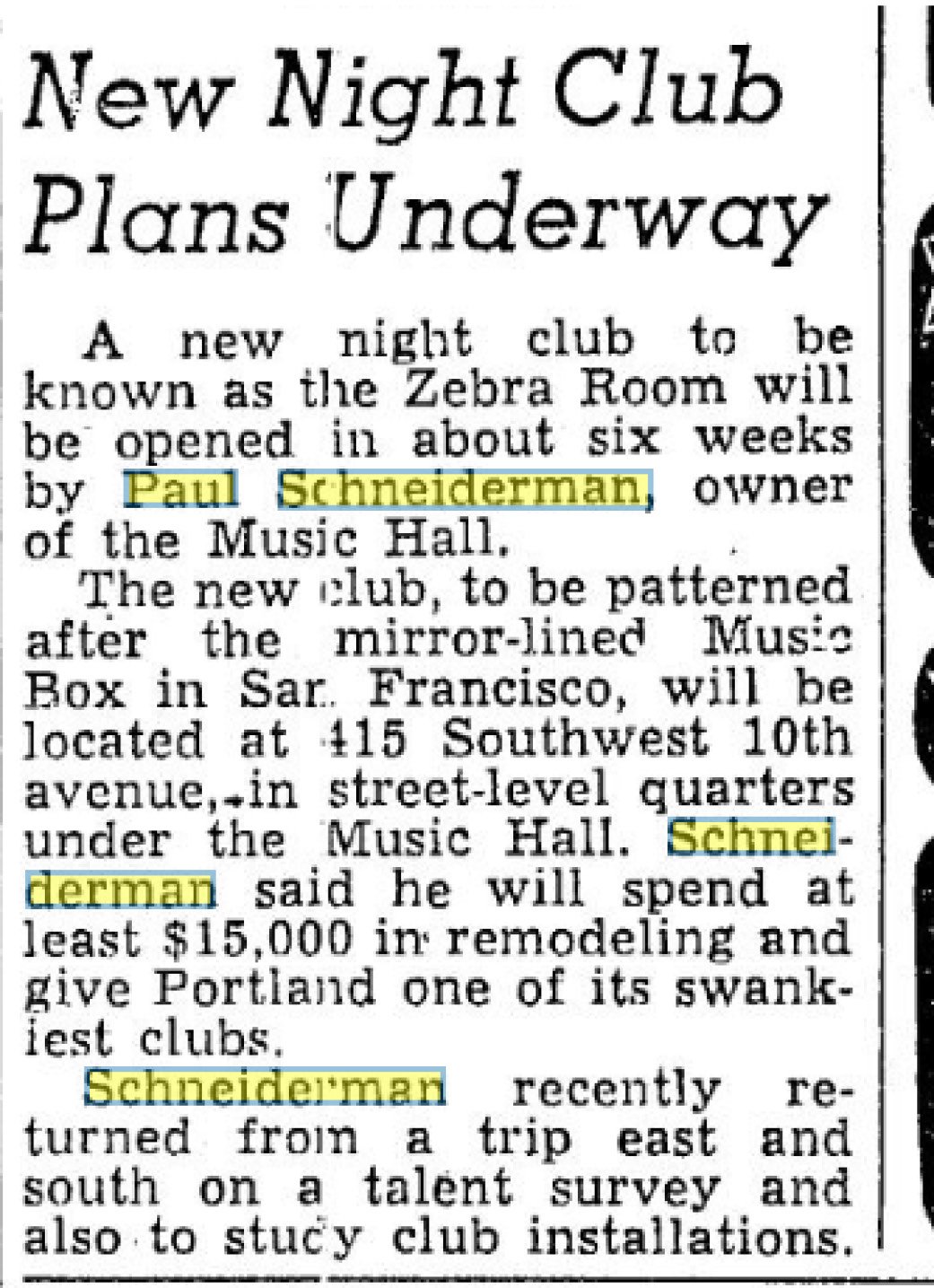
In 1944, Paul decides to add another club next door in his old space 415 per an article in the Oregonian March 13, 1944, page 7 - the Zebra Room – street level quarters ‘under the Music Hall’. Which possibly was the old Music Hall space before it moved ‘upstairs’ into the old Club Victor/Bal Tabarin space.

Paul continued to book acts for the masses. Here in an article Oregonian October 15, 1944, page 39 it also states that “it has been repainted and refurnished.”

In February 1945 when Sophie Tucker was announced, Paul had, per the Oregon Journal February 25, 1945, page 37 article that ‘the big room has been made cozier with soft tints and mirrors that break up the wall spaces…’
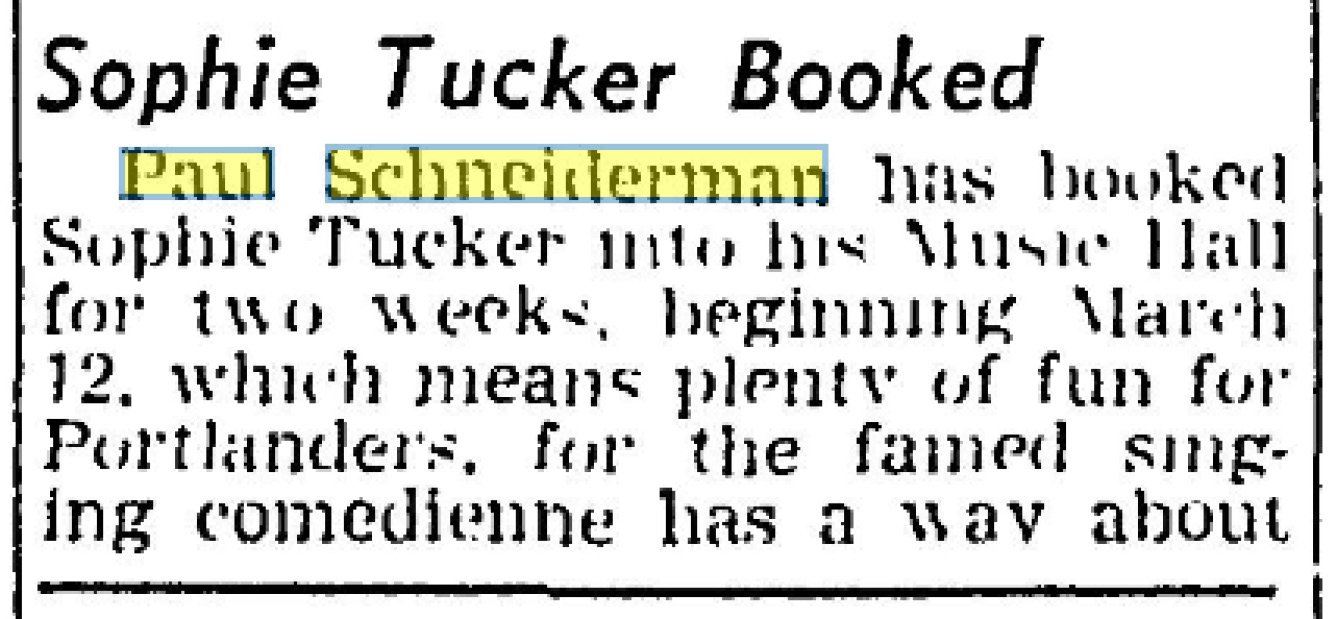
A big headliner came to star at the Music Hall – Sophie Tucker. She hadn’t performed in Portland since 1927. Per this article, Oregon Journal February 1, 1945, page 28 she was to perform for 2 weeks beginning March 12, 1945.

Right after Sophie came Sally Rand per an article in Oregonian July 21, 1945, page 9. Sally was well known for her shadow fan dance and was said to have saved two world’s fairs because of her show.
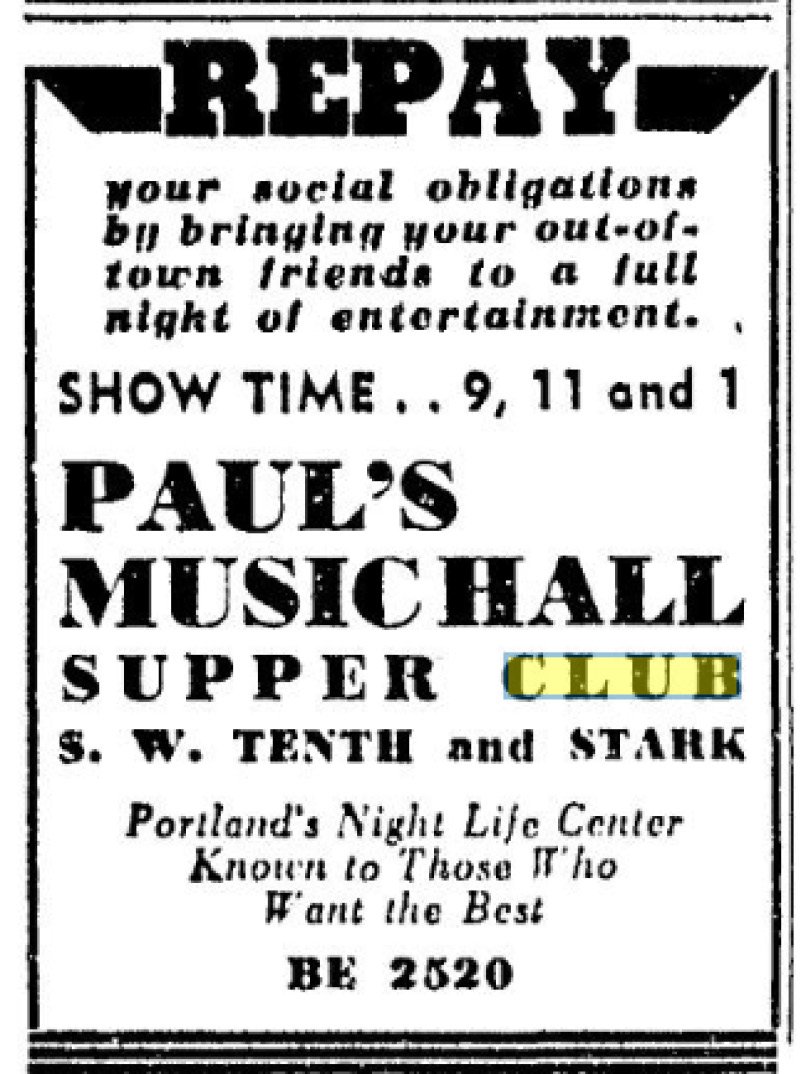
For some reason, the club was renamed Paul’s Music Hall per ad in Oregonian March 14, 1946.

As he was getting to bring another headliner to the club, Paul was hit with a lawsuit of $25,000 per the article in the Oregonian March 10, 1946, page 21. This wouldn’t be only time – take a look at 1947!
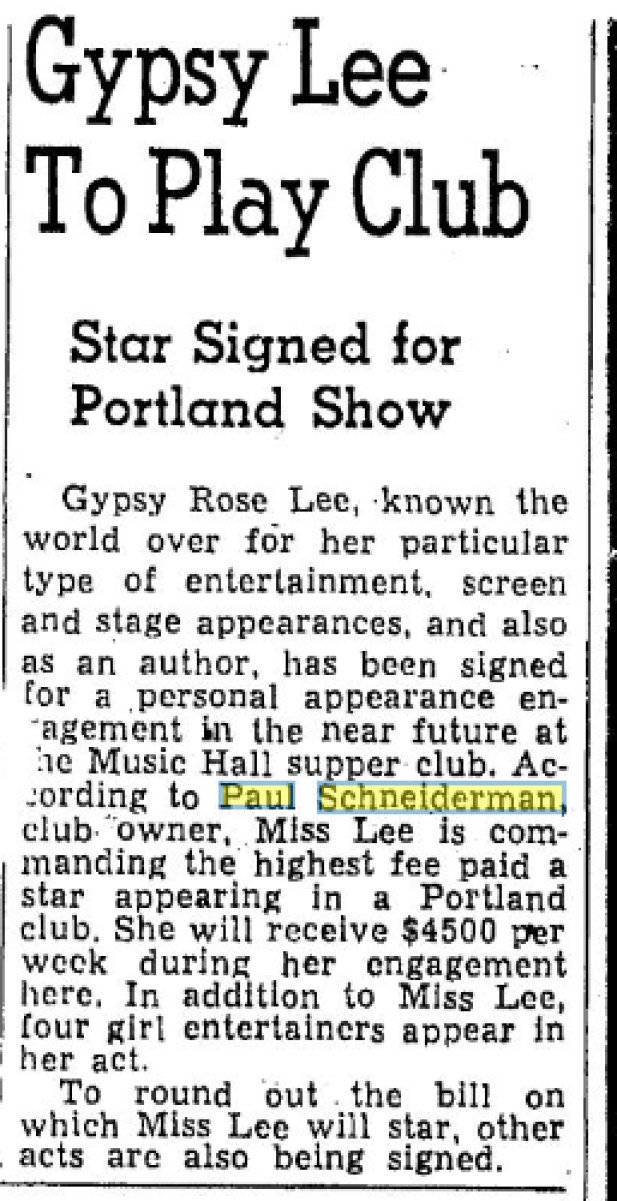
After Sophie and Sally Rand, Paul struck a deal to bring Gypsy Rose Lee who was born in Seattle, to perform at The Music Hall for $4,500 a week!
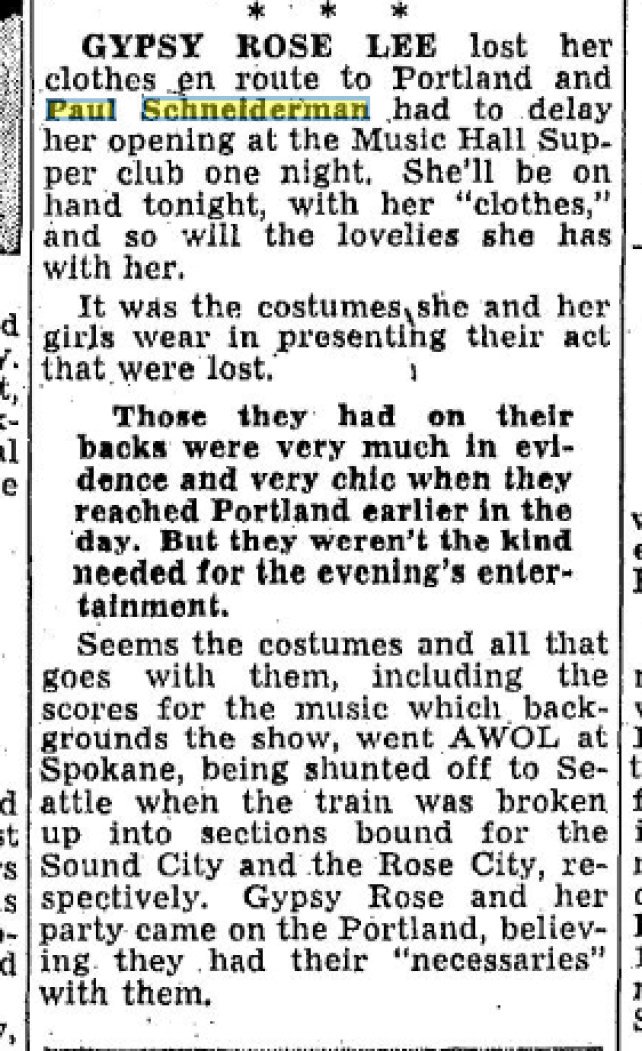
Then Gypsy Rose Lee per this article in the Oregon Journal June 4, 1946, page 23 before she could perform, her costumes were lost!
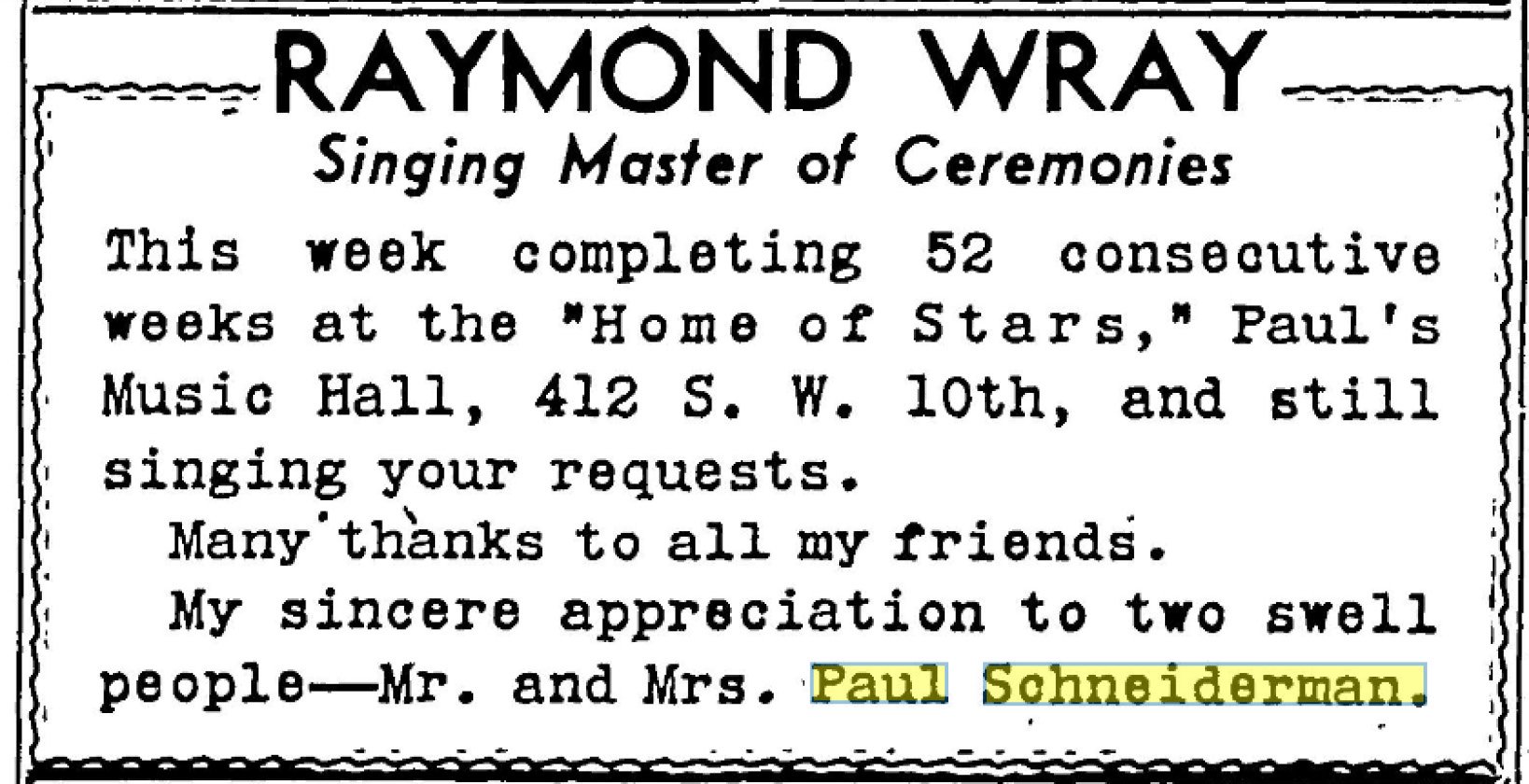
There were several articles about her appearance, one in the Oregon Journal June 5, 1946, page 24 with photo and a sort of review. An ad appeared in the Oregon Journal September 1, 1946, page 21 thanking Paul’s Music Hall for 52 weeks as the Master of Ceremonies.
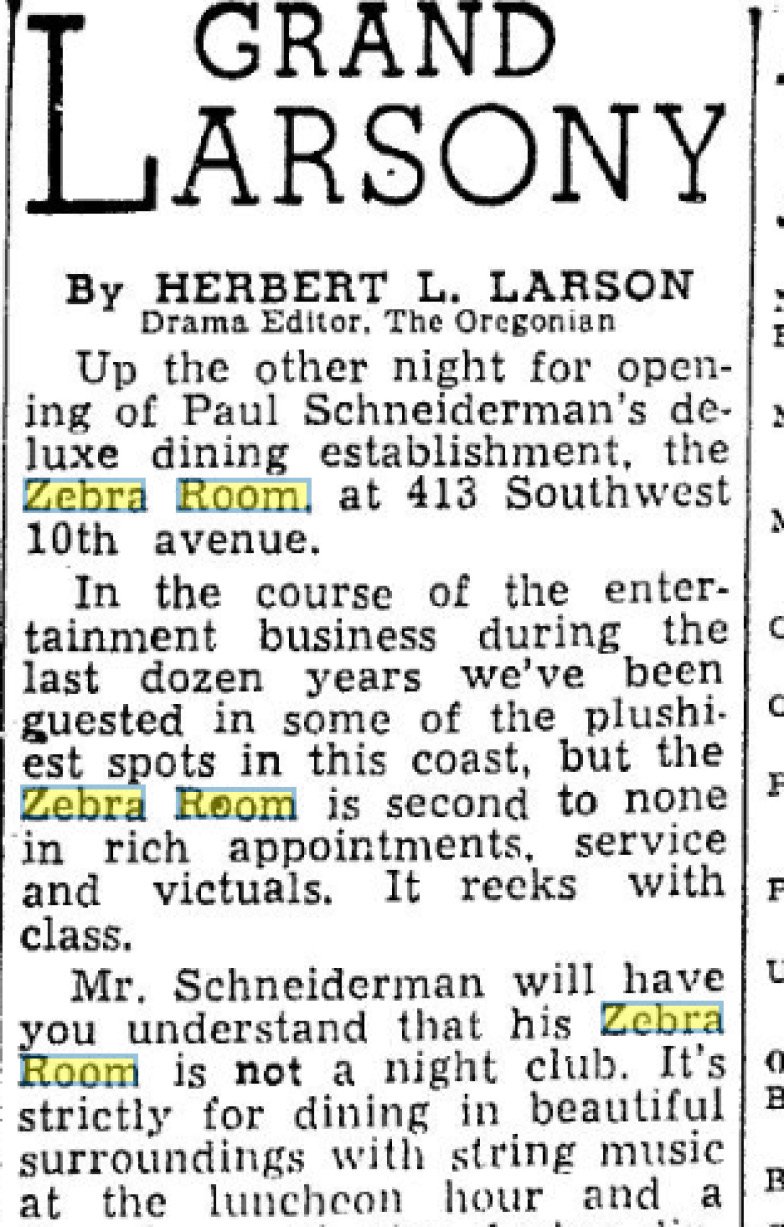
Interesting that this article in Oregonian October 14, 1946, page 4, cites the grand opening of the Zebra Room when back in 1944, Paul decides to add another club next door in his old space 415 per an article in the Oregonian March 13, 1944, page 7 - the Zebra Room – street level quarters ‘under the Music Hall’. And the Zebra Room is ‘not a night club – it’s strictly for dining…’

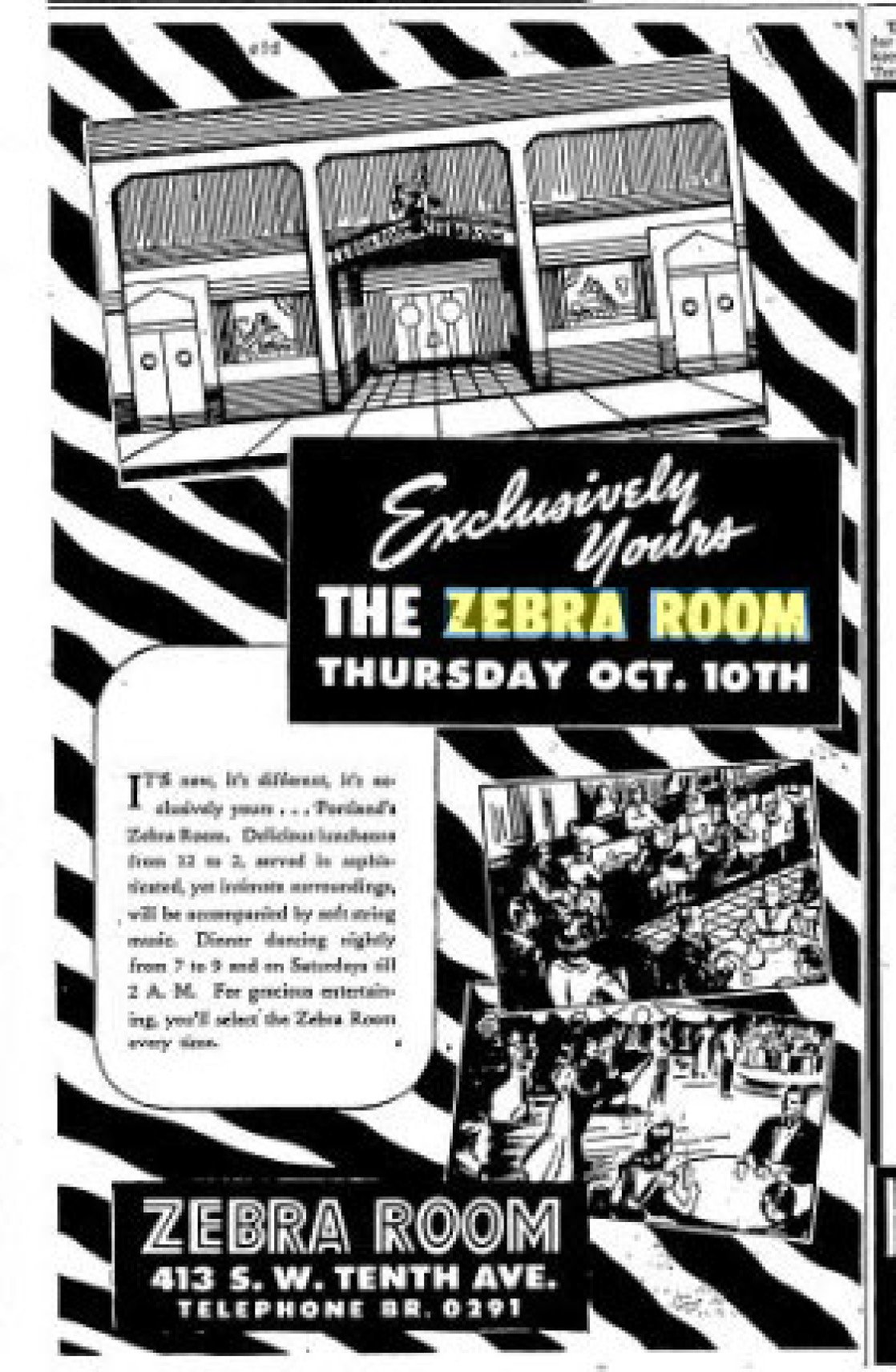
This is the first ad that appeared for the Zebra Room which ran in the Oregon Journal October 9, 1946, page 6.

By December it had changed a bit, see the ad below which is from the Oregon Journal December 10, 1946, page 26
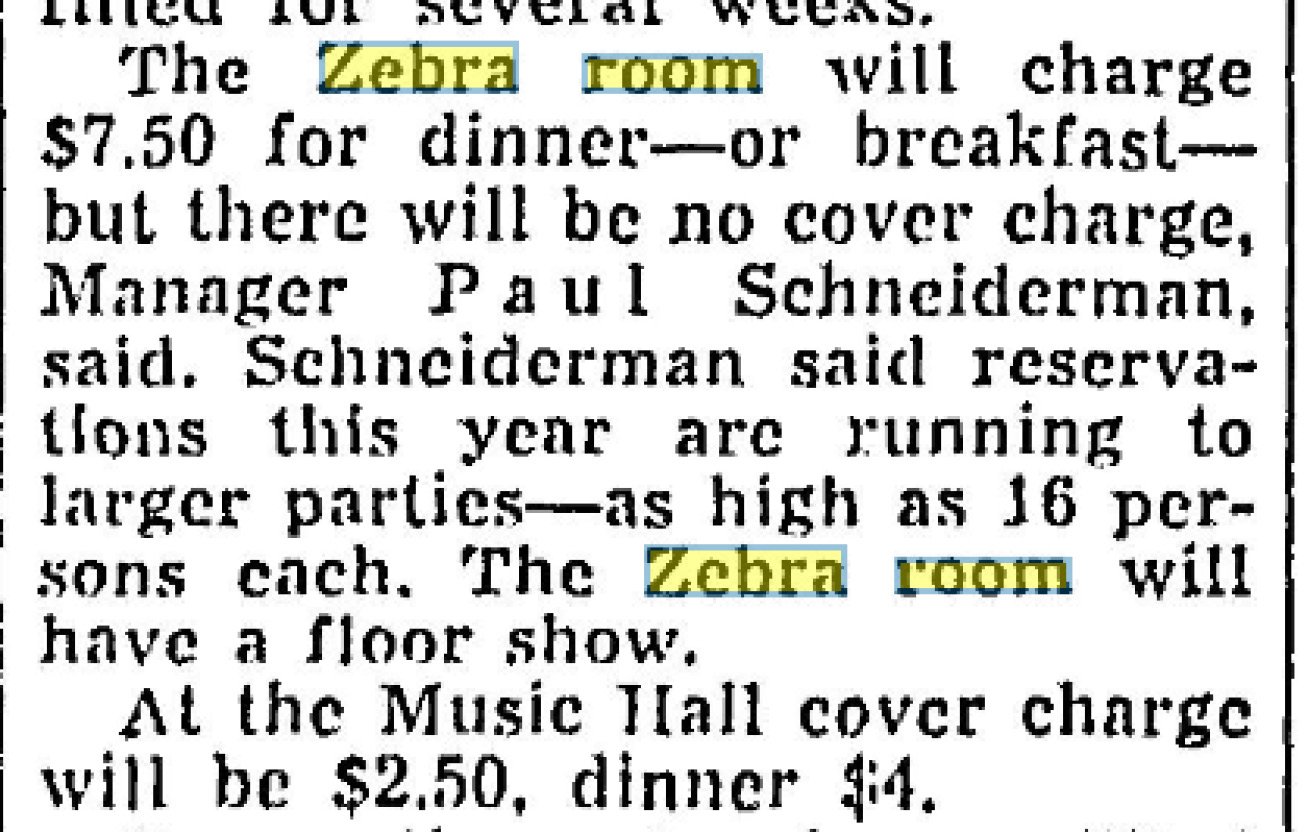
Then both spaces are mentioned in the article in the Oregon Journal December 29, 1946.
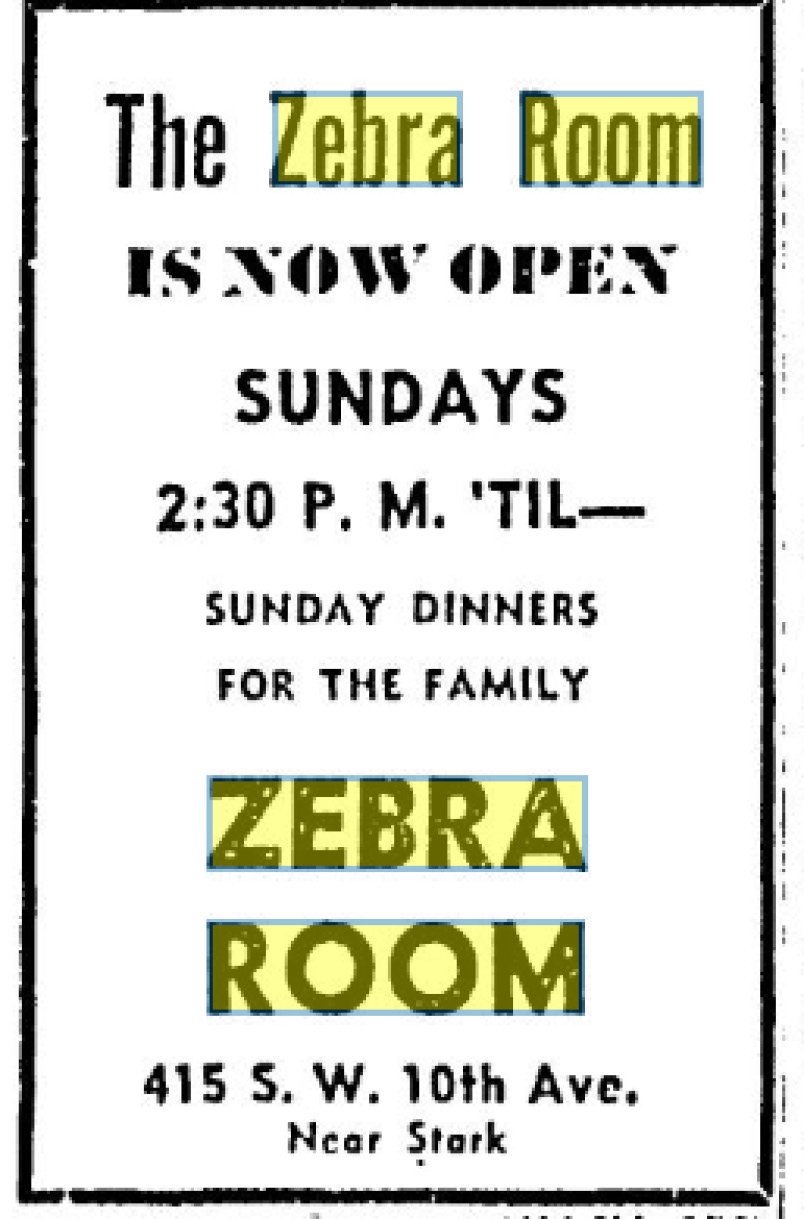
It appears that the Zebra Room was trying to appeal to a much broader crowd by adding Sunday lunches per this ad in the Oregon Journal April 11, 1947, Page 4 as shown below.
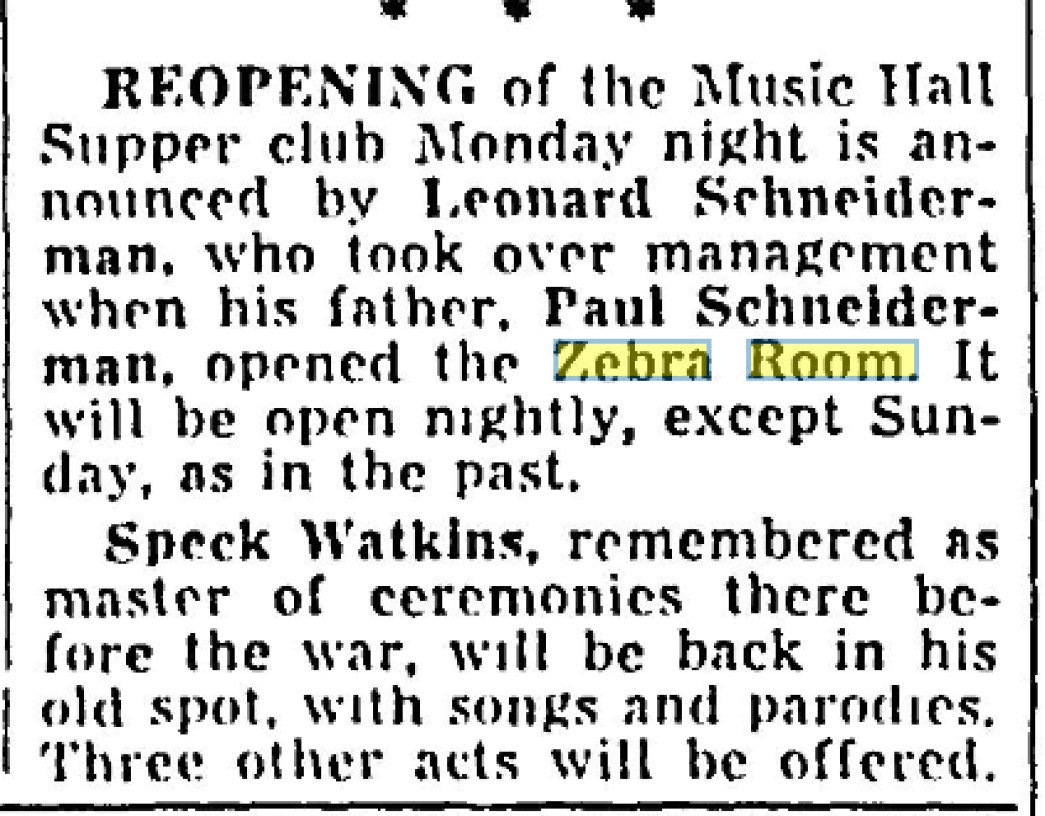
What is unclear is why there is a ‘reopening’ – this article in the Oregon Journal May 11, 1947, page 28 because the Zebra Room has been open since October 14, 1946, per the article in the Oregon Journal unless it was father Paul and son Leonard to receive more press?
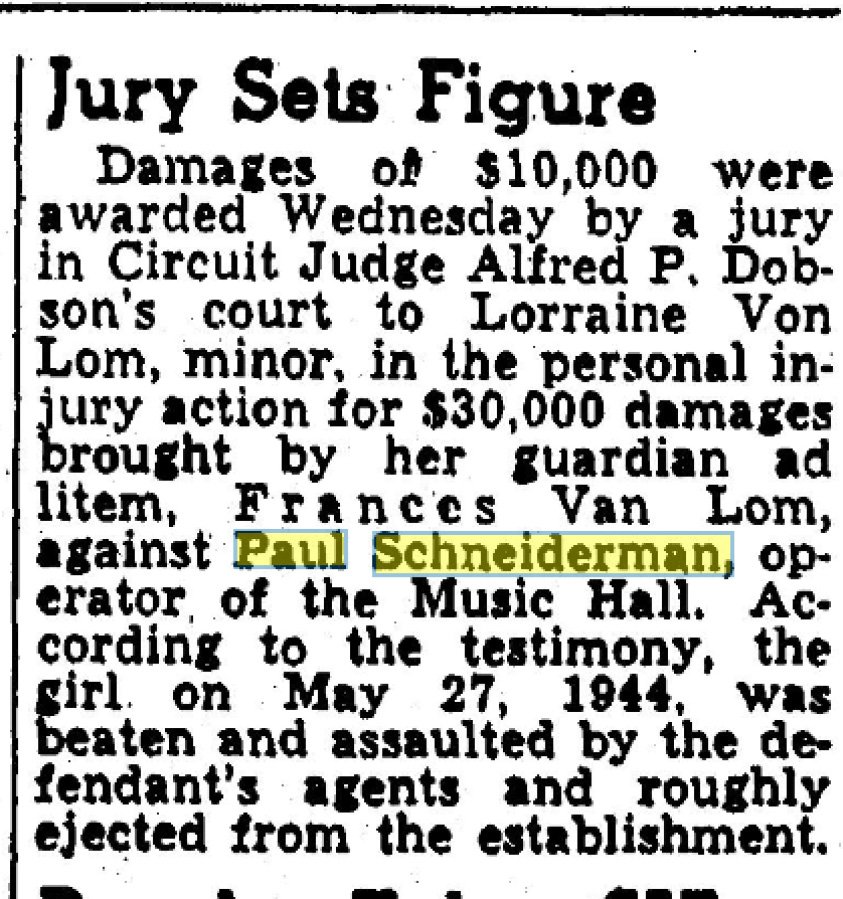
In 1945 Paul was again sued and a large settlement of $10,000 per article in Oregonian, November 27, 1947, page 13.
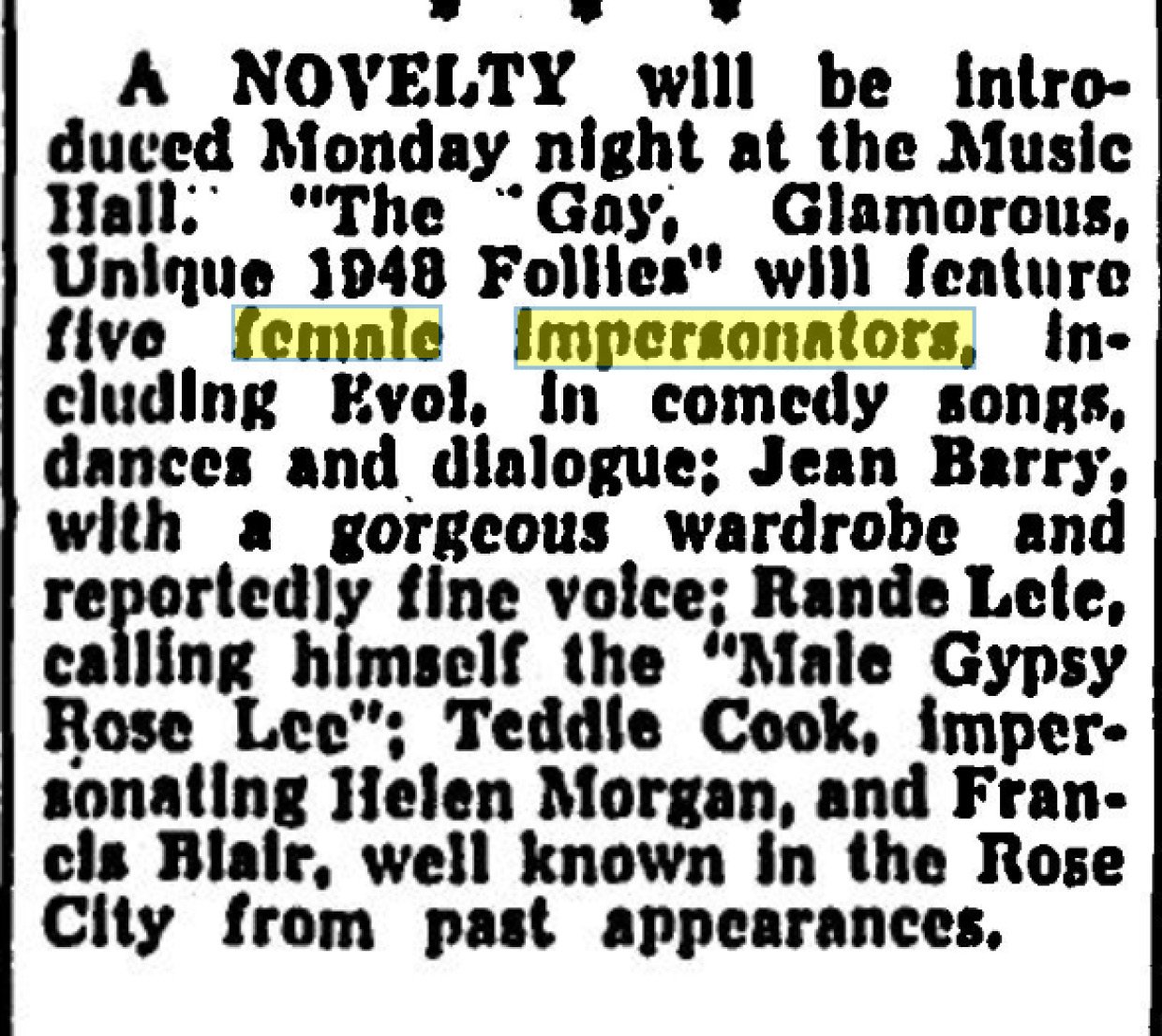
By January 1, 1948, per an Oregon Daily Journal Article A NOVELTY will be introduced Monday night at the Music Hall. “The Gay, Glamorous, Unique 1948 Follies” will feature five female impersonators. Leonard is running the Music Hall at this time. Also: It is the first mention of Francis Blair – who was from Seattle, WA and performed at the Garden of Allah which closed in 1946. It states though “well known in the Rose City for past performances.”

Now by January 7, 1948, an ad in the Oregon Daily Journal proclaimed “They’re the Talk of the Town”.
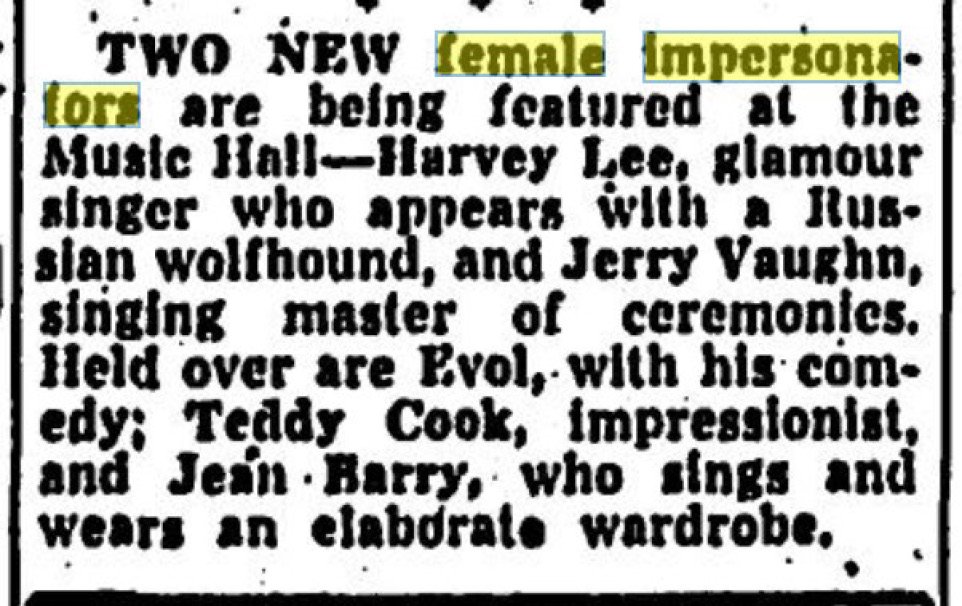
The female impersonators performing at the Music Hall included a pretty well-known female impersonator, Harvey Lee. He had worked at Club My-O-My in New Orleans and The Jewel Box Revue. It is unknown, but he may have been hired by Danny Brown who was the co-director, co-founder of The Jewel Box Revue. See article below from The Oregon Daily Journal dated January 25, 1948.



By February 1, 1948, the Oregon Daily Journal “bringing in a girl who will impersonate a man as master of ceremony.” And cited Paul as the one to do this, when Leonard was the one running the Music Hall, unless as mentioned before it was just a ploy for more media coverage.
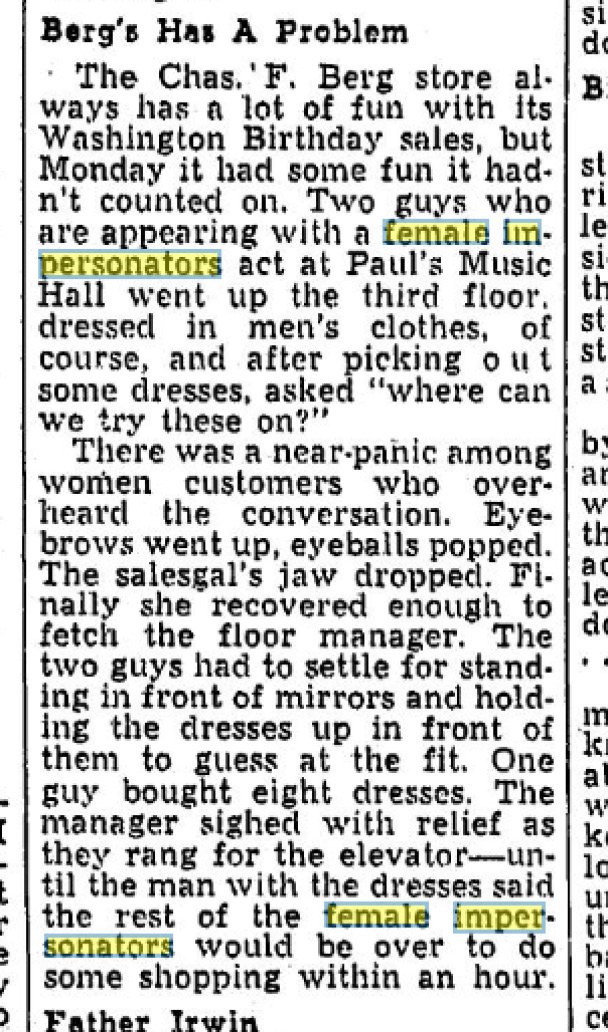
Charles F. Berg was a store on Broadway in downtown Portland. The press was alerted per an article in the Oregonian dated February 24th and with a headline that read, BERG’S HAS A PROBLEM “Two guys who are appearing with female impersonators act at Paul’s Music Hall went up the third floor…after picking out some dresses, asked ‘Where can we try these on?’”
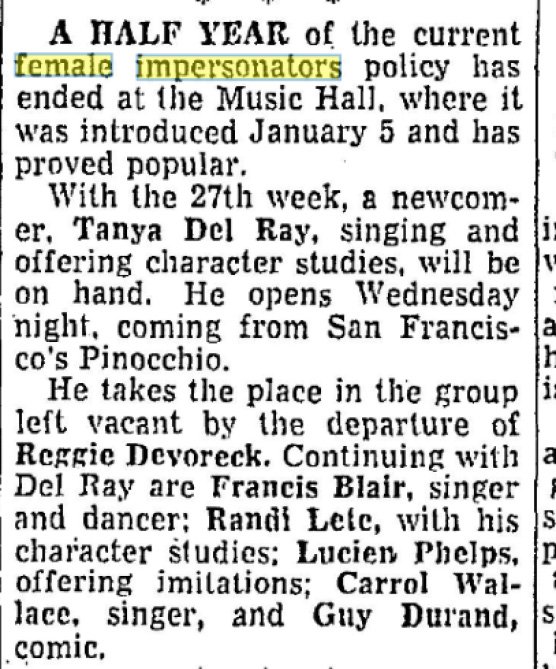
By July, the press as seen below in the Oregon Journal reported that female impersonators had been performing at the Music Hall since January 5, 1948, for one half of a year. A new person was added Tanya Del Ray from Finocchio’s/San Francisco.
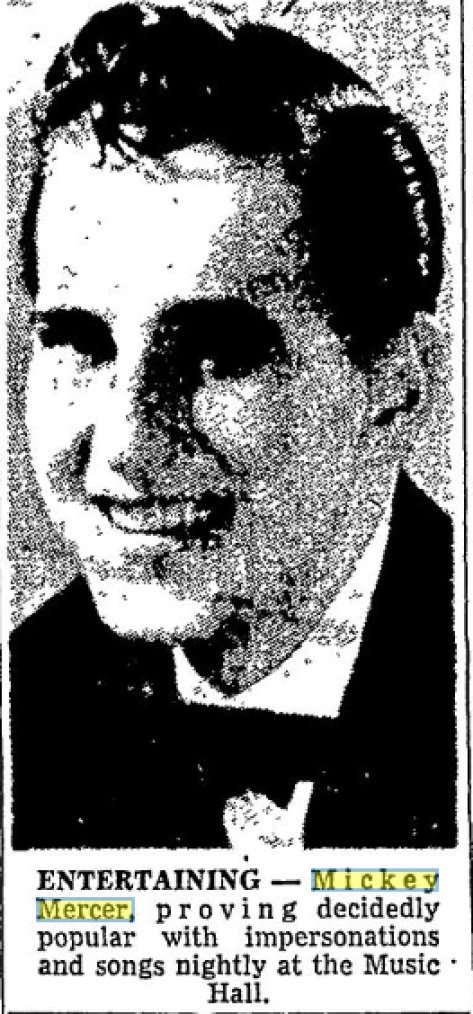
1948 – July 31 Oregon Journal – “Planned return of Jimmy Renard as male impersonator and mistress of ceremonies failed to materialize, but another of her sex will be added August 14 – Mickey Mercer.” 1948 – September 1 Oregon Journal – photo and ad top and bottom of ad – Mickey Mercer is female who impersonated a man. And with a new by-line, ‘Boys will be girls!”


Around this time, 1948 – September 23 an ad appeared in The Oregonian that the Star Theatre 6th/Burnside had “Billie Devoe, New Orleans Bombshell, Female Impersonator” performing and next to it, another ad in same Oregonian (side by side) The Music Hall
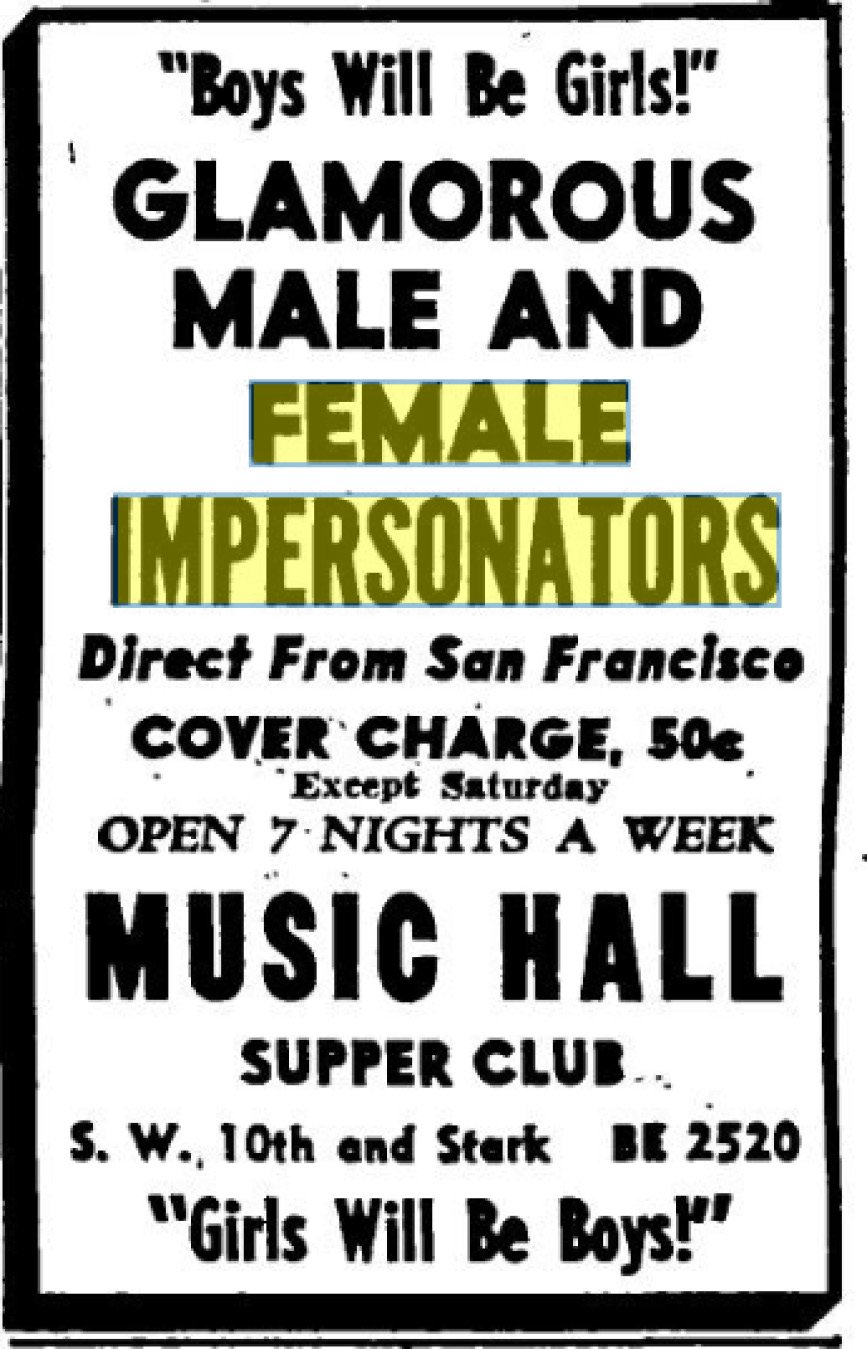

For the rest of 1948 and 1949 almost weekly, there was either an ad or a column mention in the Oregon Journal about the Music Hall. By November Gita Gilmore, a well-known female impersonator, was added to the cast per an article in the November 28, 1948, edition of the Oregon Journal. Gita also was in The Jewel Box Revue.
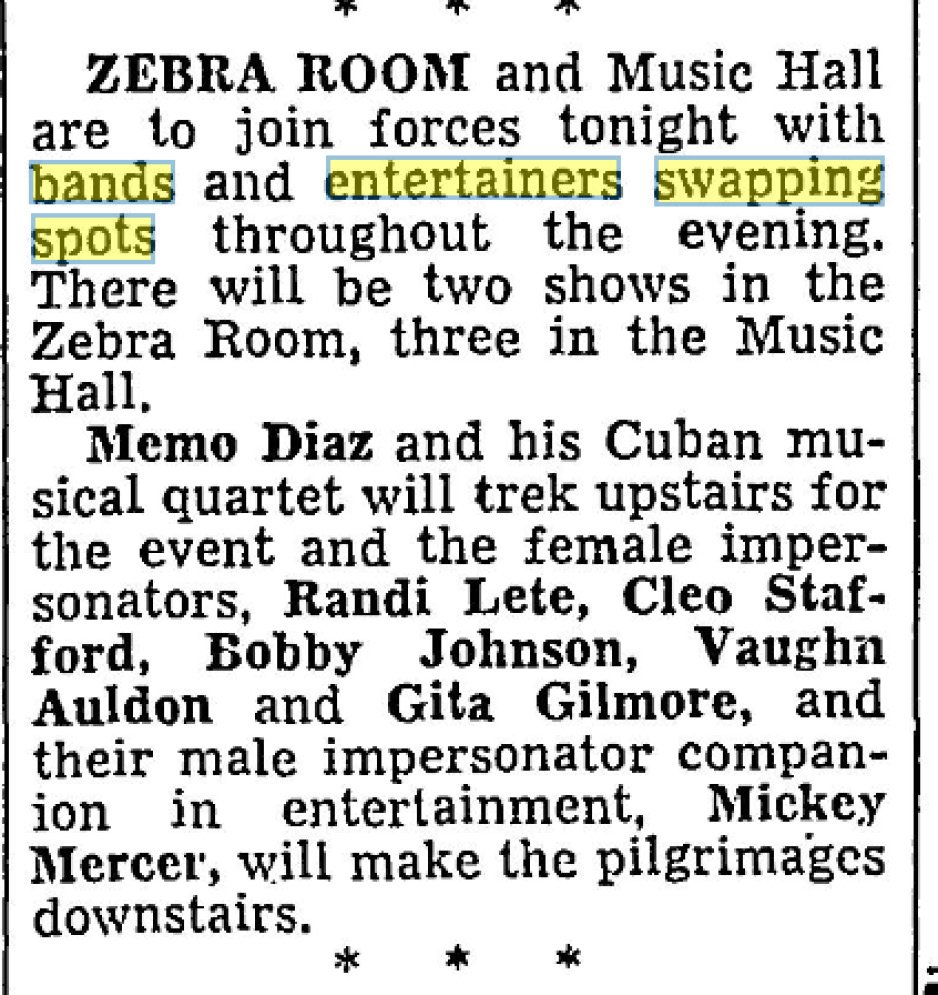
Then by the end of 1948, and per an article in the December 31 Oregon Journal, page 7, “The Zebra Room and Music Hall join forces…bands and entertainers swapping spots… will trek upstairs for the even and the female impersonators…” Zebra Room was downstairs of the Music Hall.
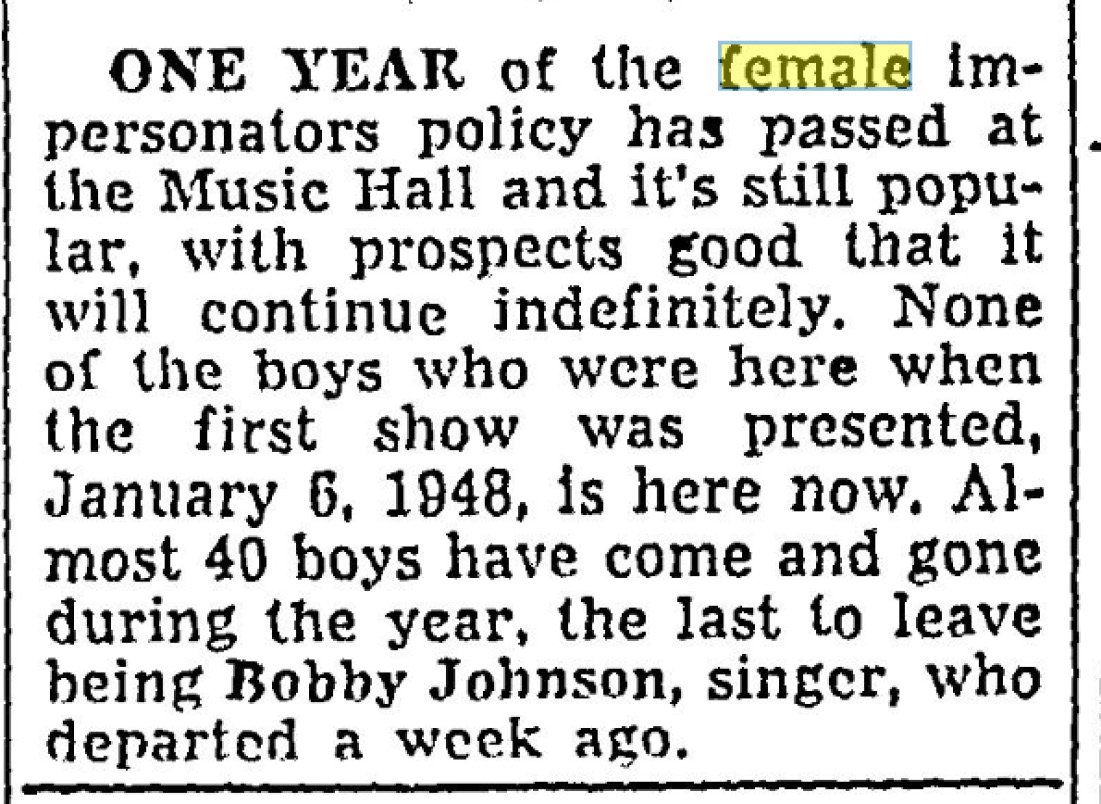
This is the last time that the Zebra Club is mentioned in the press or any ads in any newspapers. The space does not appear to be used again. As 1949 started, the Oregon Journal on January 9 proclaimed the ONE YEAR of the female impersonators policy…

Two ads appear side by side in the Oregon Journal January 14, 1949, page 16
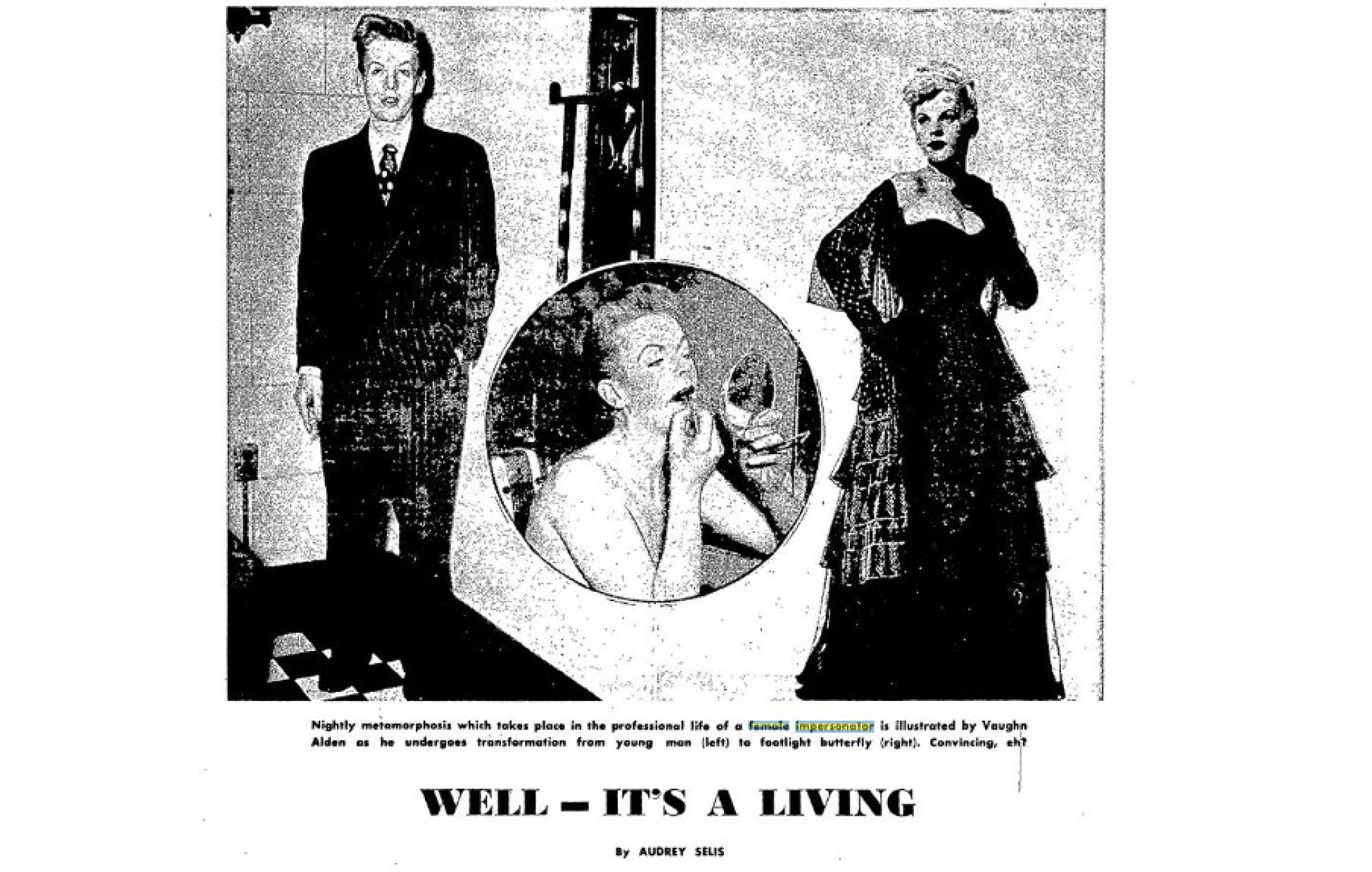
1949 – February 6 Oregon Journal “…have helped along the March of Dimes campaign…” By May 1, 1949, the Oregon Journal had a full page spread about being a female impersonator entitled, “Well, it’s a living”.
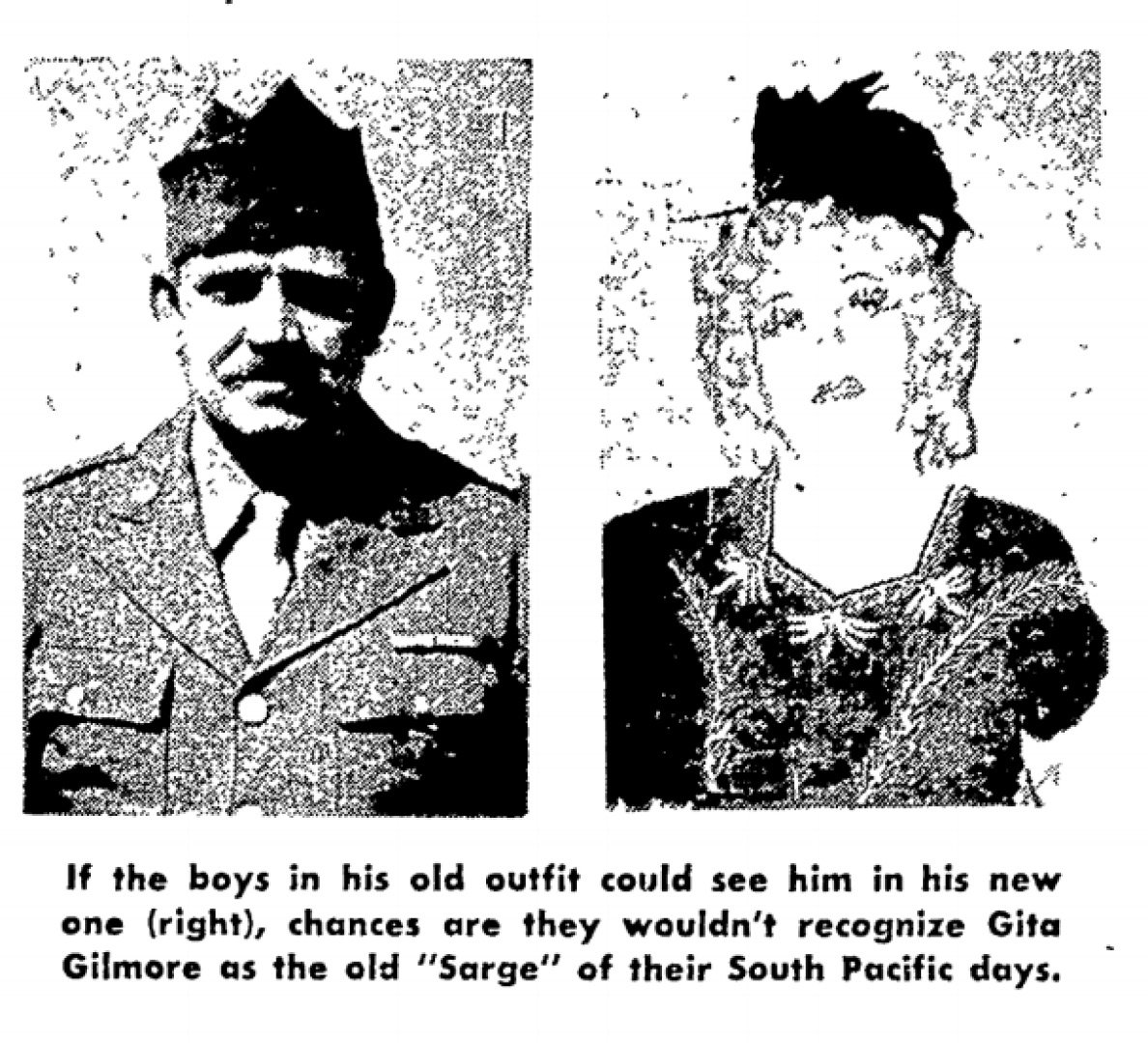
This article included Gita Gilmore. [Sunday Oregonian May 1, 1949 article “Well – It’s a Living” which included these two photos.

Many of the female impersonators up to this time came from the now closed Garden of Allah in Seattle, Finocchio’s in San Francisco, or Club MY-O-MY in New Orleans. Here, stated in a May 29 Oregon Journal article cites that a performer had come from New York City’s “Club 181”.
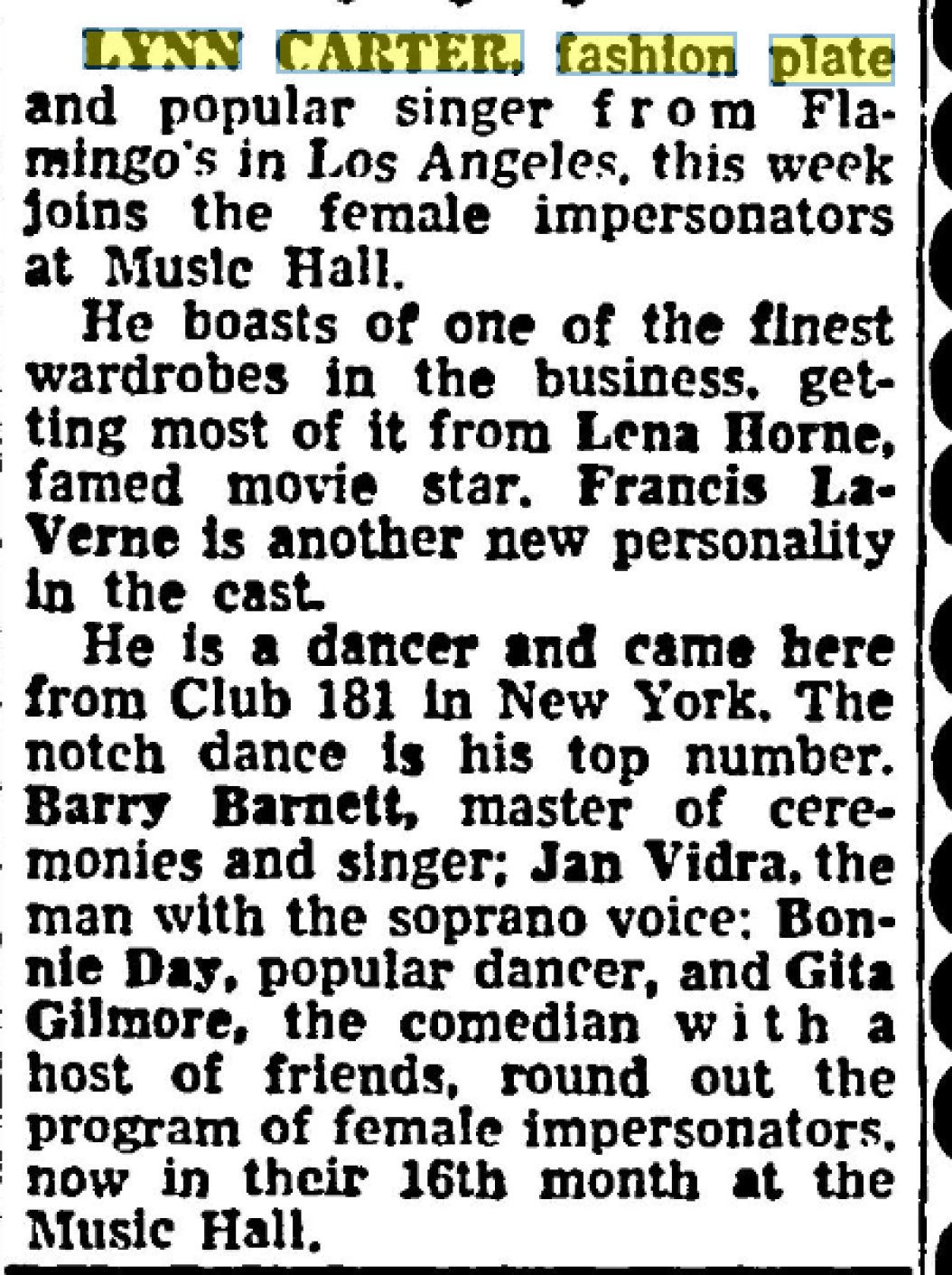
The Music Hall was getting major female impersonators which included Lynn Carter from Los Angeles cited here in a 1949 July 3 Oregon Journal article.
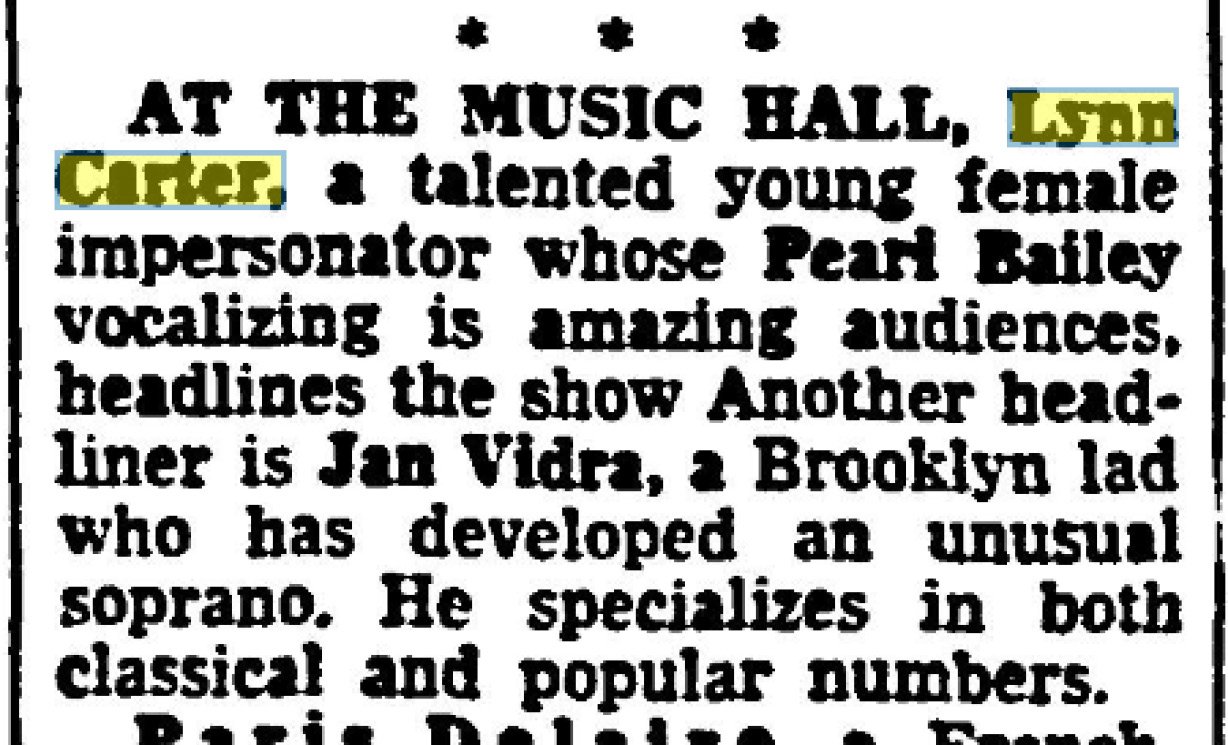
Another great notice in the 1949 July 23 Oregon Journal about Lynn Carter.
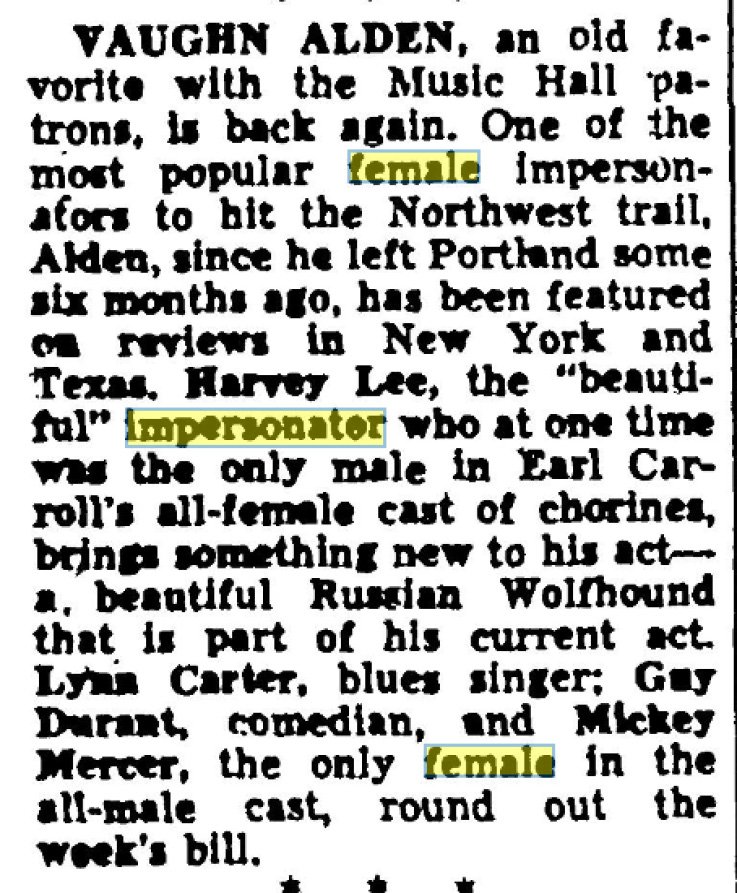
Press reports were coming out of the Music Hall right and left adding, changing, or keeping various performers. Example this article in 1949 October 16 Oregon Journal.
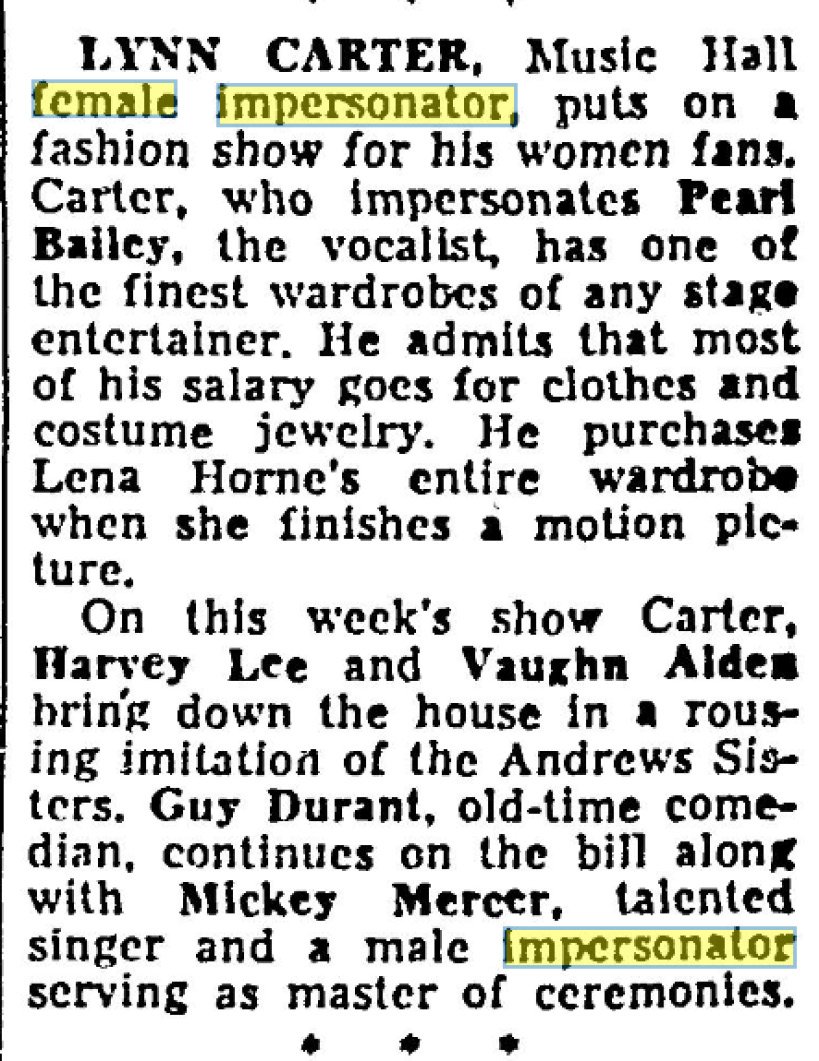
The Music Hall even held a fashion show put on by female impersonators per this October 23 (1949) Oregon Journal article.

Did you know there were even canine female impersonators? Well, per the 1949 November 6 article in the Oregon Journal it’s true!
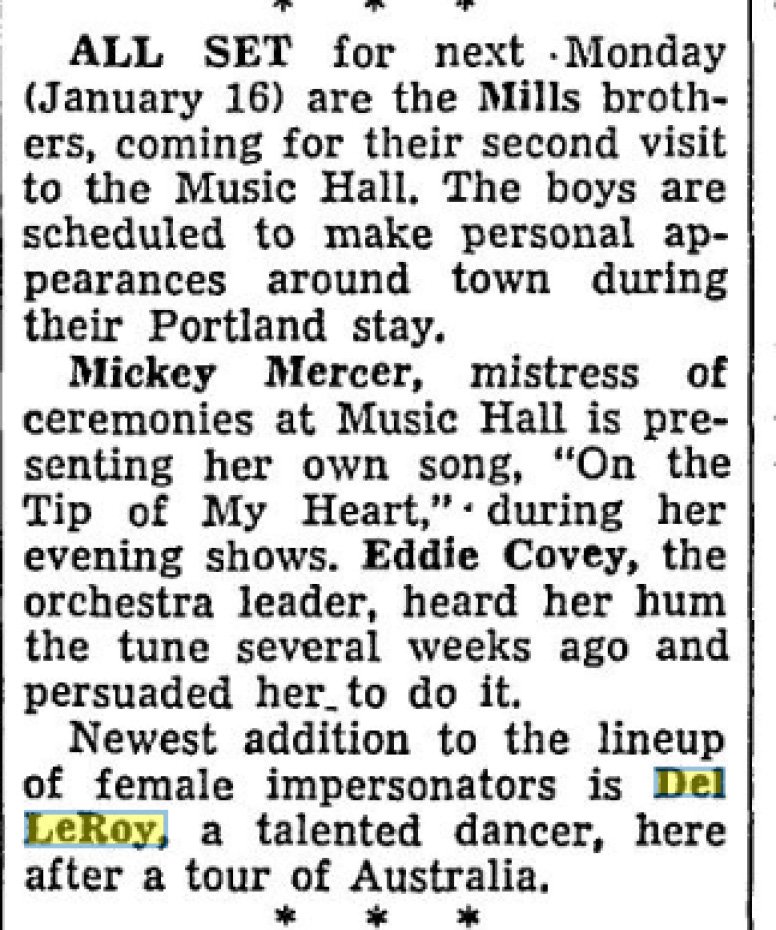
The Mills Brothers were announced to play at the Music Hall in an article dated January 8, 1950, in the Oregon Daily Journal for their "second time at the hall”. The article also introduced a new female impersonator, Del LeRoy, a talented dancer, here after a tour of Australia.
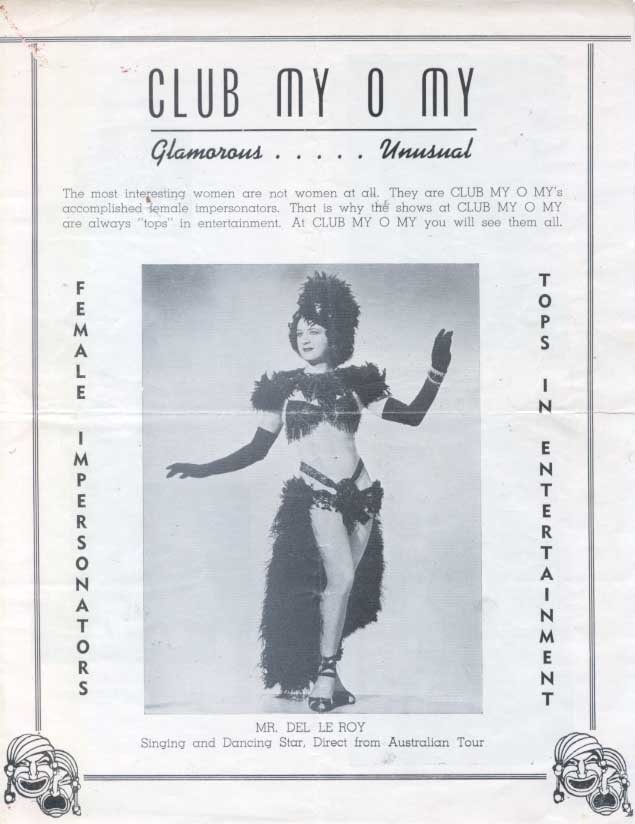
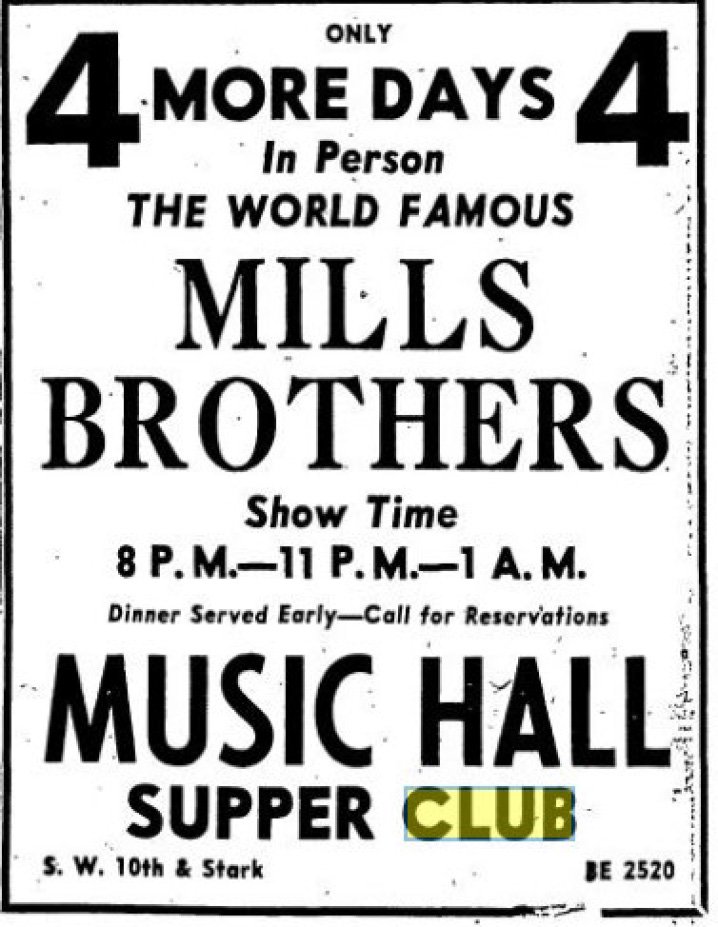
The Mills Brothers played for two weeks, here is an ad in the Oregon Journal January 26, 1950 stating their last four shows.

During the Mills Brothers run, various people from the city and others came to see the Mills Brothers act. And on March 17, 1950, on the front page of the Oregon Daily Journal it was announced that the Music Hall was to close.
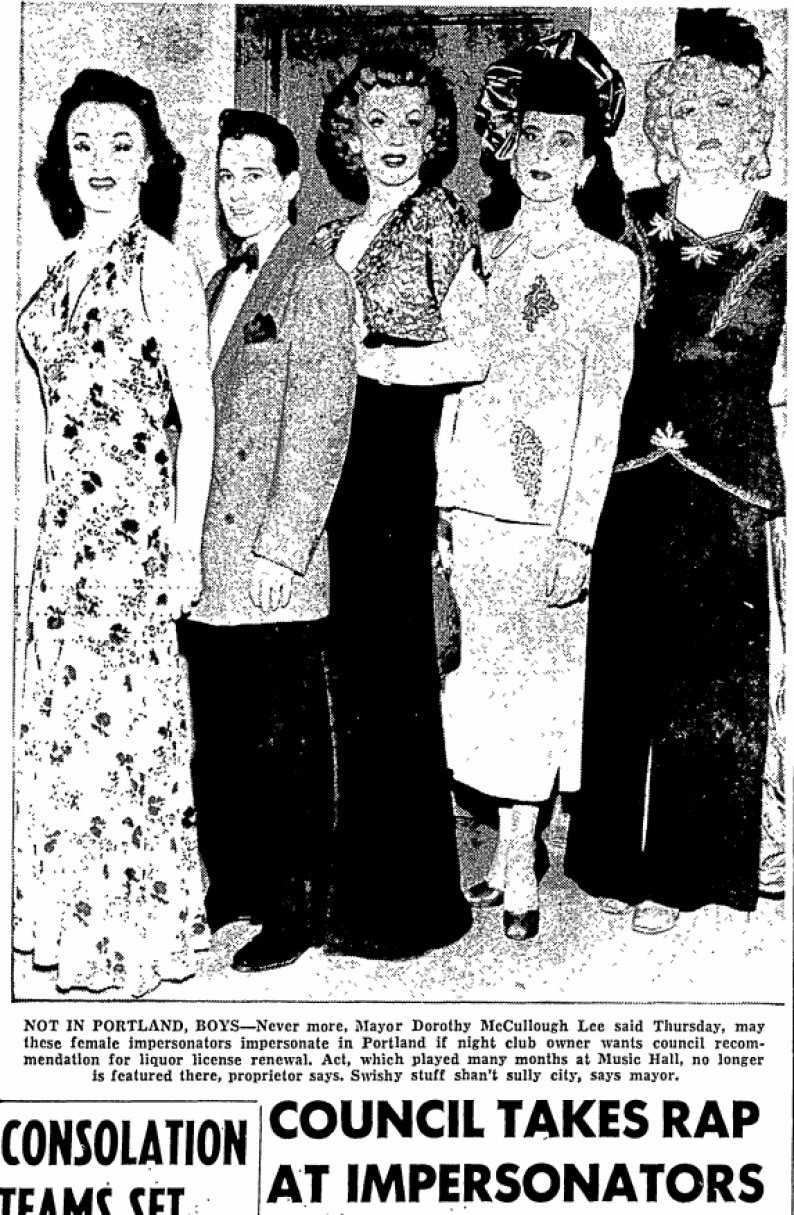
On March 17, 1950, the front page of the Oregon Journal exploded with the photo of the entertainers at the Music Hall and in the article, it stated that Leonard Schneiderman requested a waiver on obtaining a liquor license at the Music Hall. It was reported in the Oregon Journal, “application(s) received favorable recommendations, but the Schneiderman application was recommended only after the council insisted the hall no longer employ female impersonators and discourage patrons who are homosexuals.” Per article in the newspaper Northwest Gay Review, June 1977 written by W Holman “A Gay History – lest it be forgotten” sheds may stories on gay life from World War II to Stonewall. “Close to the roar of printing presses was a dimly lit Rathskeller. The Circle and Capitol Theaters were between Broadway and the river; their balcony -smoker sections were like chessboards whereon a queen could move in any direction to take a check pawn or knight, bishop, or king. Nearby was the Backstage with drag shows – and Lucien – in the upstairs Music Hall. The fame of both Backstage and Music Hall was widely known to “that percentage in the know;” their demise became more widely known when, in ’49 a gust from City Hall toppled their purpose Lee-ward. The Rathskeller evolved into the Rhumba Room. It too was toppled – more likely from the play in the john than the show on stage.
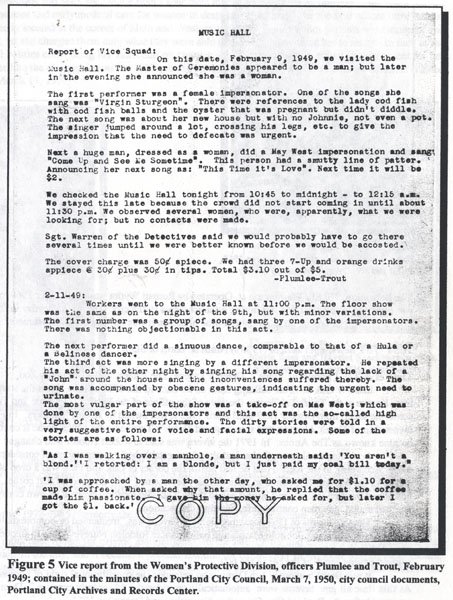
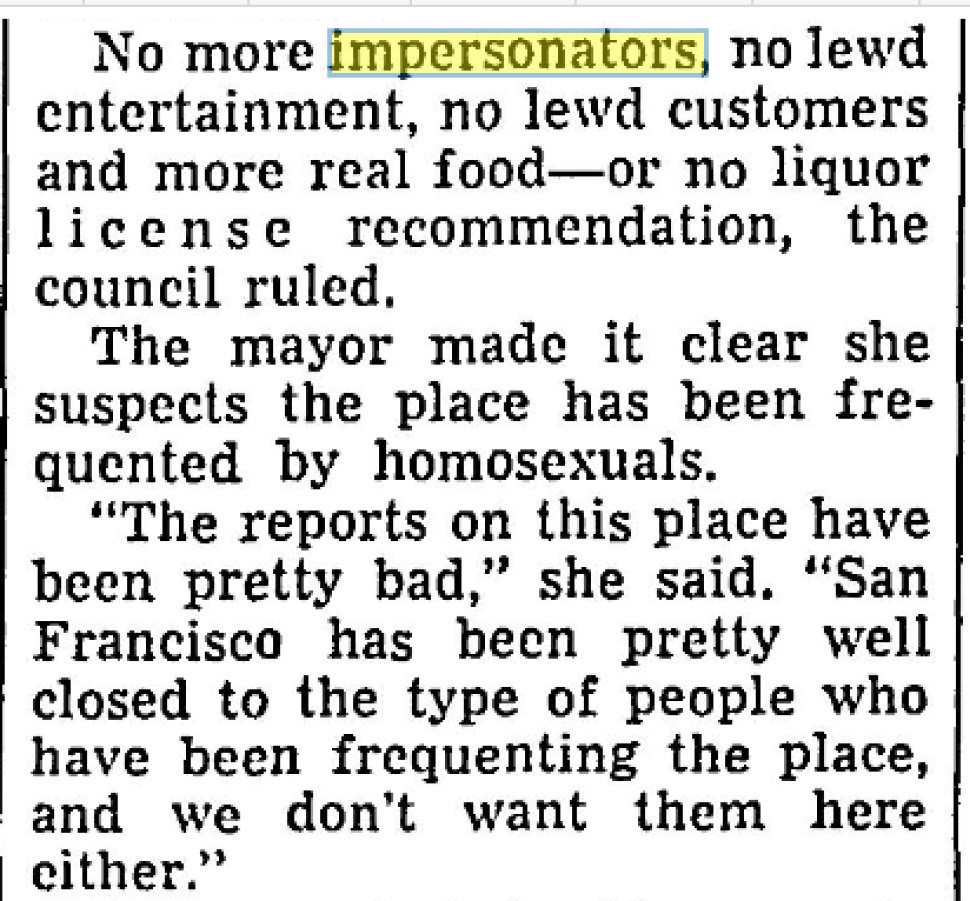

On page 4 of the same article in the Oregon Journal March 17, 1950 it states, “the council insisted the hall no longer employ female impersonators AND discourage patrons who are homosexual.”
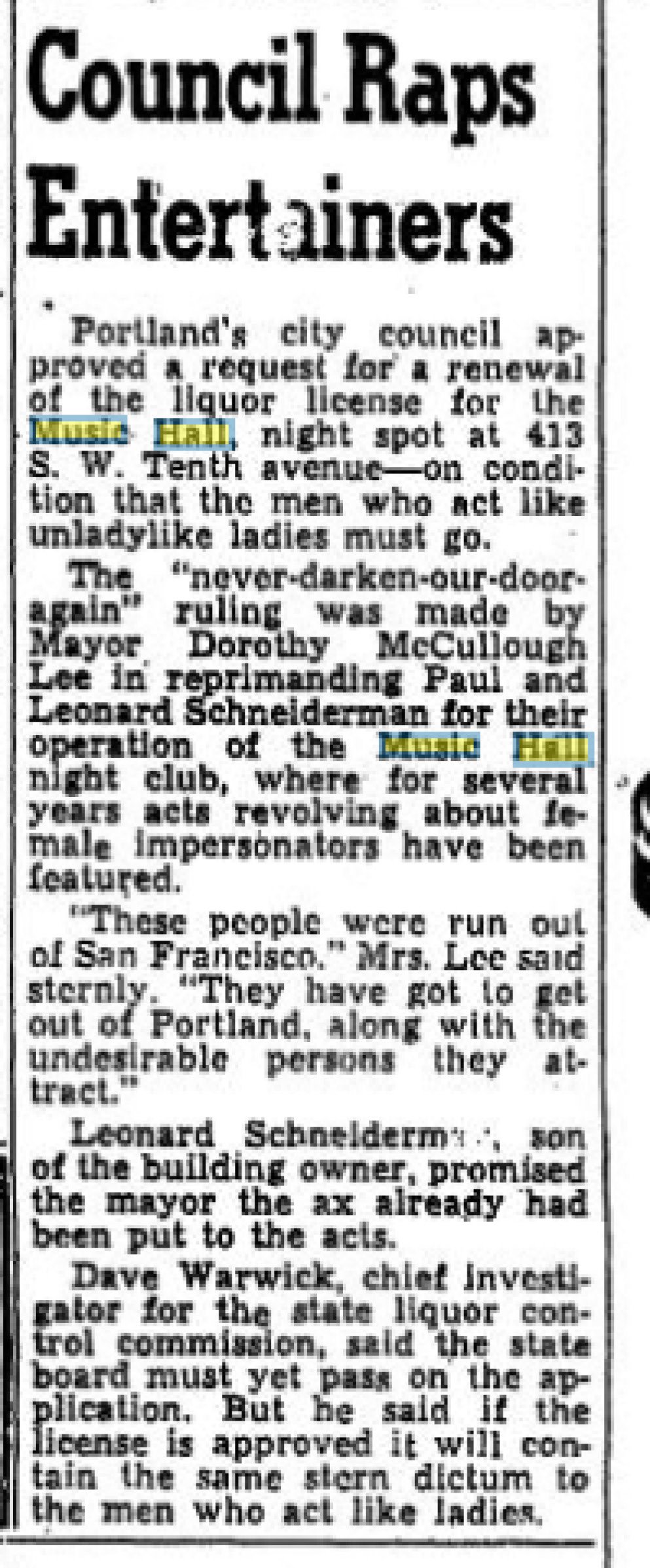
In the same paper, Oregonian March 17, 1950, page 9 Leonard promises no more acts at the Music Hall. This is the last time Paul, Leonard, The Music Hall, Zebra Club are mentioned together as by August another person was taking over.
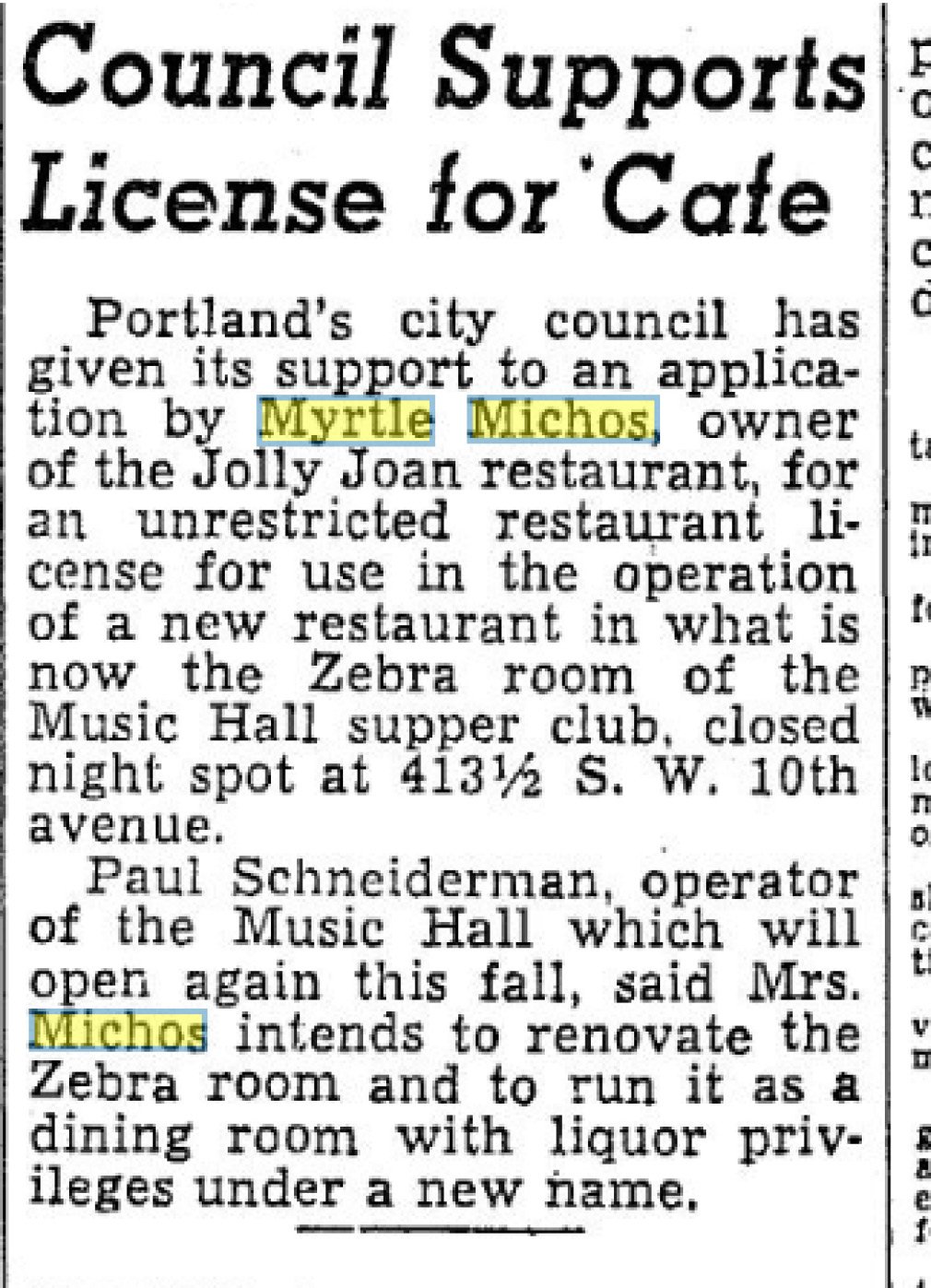
Myrtle Michos and her husband Tom were co-owners of a very popular eatery, Jolly Joan’s. They divorced and it appears that she had plans of her own to start place per the Oregonian August 19, 1950, article on Page 10.
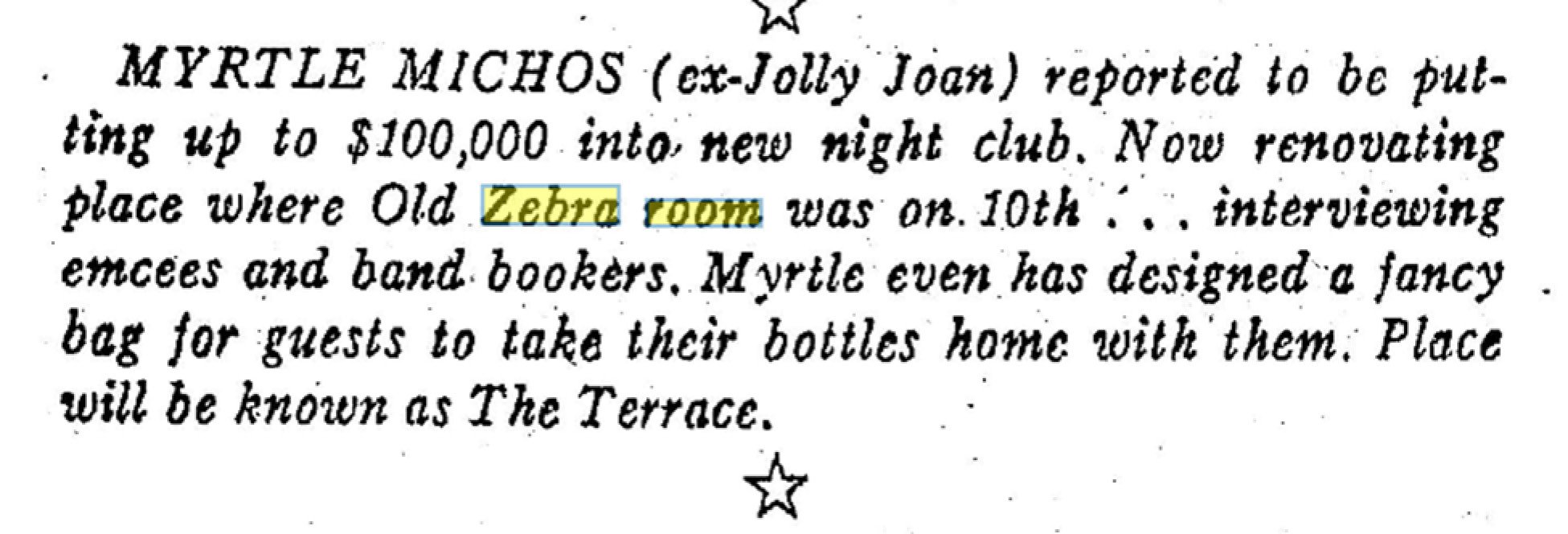
Another notice in Oregonian November 10, 1950, page 22

Per papers that are called Chronology of Portland’s Gay Bars – author unknown, “Schneiderman’s Music Hall, 413 SW 10th St 1937-1949; closed down by Mayor Lee in 1949 purge of homosexual hangouts; featured early drag shows.” Per the GLAPN - A Walking Tour of Downtown Portland: A Century of Gay, Lesbian and Transgender Historic Sites June 1999: “Tone of the highlights of Portland’s gay and lesbian history is a visit to this wonderful building where in the late 1940’s following World War II, much of the city’s queers came for entertainment and socializing. Opened by a Russian Jew named Paul Schneiderman in 1937, the nightclub took its name from the tradition of the old English Musical Hall. Early on it featured vaudeville type entertainment as well as big name acts. At some pint (around 1947 we believe) Paul’s son Leonard booked a San Francisco female impersonator’s troupe, and the rest is history. The nightclub soon blossomed with a lively mixed lesbian and gay crowd that howled with laughter at the double entendre and risqué innuendo of its entertainers. Duane Frye who frequented the Music Hall at this time recalls, "My first bar was The Back Stage and named thus, as it was connected by a back stairway to an upstairs night club named The Music Hall where drag shows were performed nightly. There was some genuine talent in the Music Hall shows as Mickey Mercer, a female tenor, emceed the shows with headliners such as Harvey Lee, the only female impersonator to ever work in Earl Carroll’s Follies in Hollywood. He was elegant and dressed in wonderful costumes and was truly beautiful. He used a white Russian wolfhound in his stately act. Unfortunately, the hound fell in love with the pianist and often spoiled the illusion and mood straining at the leash to be with the object of his affections. This was before lip synching, so all the drags sang their own songs…other performers such as Lynn Carter performed there and later became quite well known on the East coast while Jerry Kline remained in the Portland area and later became a hair stylist. Dorothy Lee was mayor of Portland at the time. There were never any problems with the police department at that time even though gay bars were thought of as illicit in most of the states. There were never any problems with the police departments at that time even though gay bars were thought of as illicit in most of the states. There were no crackdowns as happened in what was thought of as more liberal places such as San Francisco. Unfortunately, the Music Hall billed a very popular trio at the time, The Mills Brothers, for a run of performances, and instead of omitting the drag shows, included them on the bill. Among the crows that paid to see The Mills Brothers was the City Council who were offended by the inclusion of the drags and upon investigation discovered that both The Music Hall and the Backstage were being run on the same liquor license and they closed both places down – never to re-open.” Duane Frye’s full interview was again printed under GLAPN’s Reflections section of the 1993 Portland Gay*Lesbian*Bi*Trans Pride Parade & Festival June 20-21, 1993, page 11 and 19. Here is the balance of the interview: There were other gay places at that time as well. The Cupboard located next to the Broadway Theatre, a beer bar and later named the 19th Hole. The Pantry wasn’t strictly gay but had a mixed clientele and frequented by many gays as they could buy cocktails there and also have dinner; however, it didn’t last too many years. Bob Saunders opened the Tel and Tel Tavern on Oak Street and I worked there a short time as beer tender. Later, it was sold to Derek and went by that name until it became The Family Zoo. The Harbor Club and Dahl and Penne were liquor bars and very popular and. Had huge crowds. The space was somewhat limited at the Harbor club and there were often long lines waiting to be allowed in, so as not to flaunt the fire code. Leo Kennedy owned the Half Moon Tavern, and it was a popular meeting place until the property sold and is now Riverside West. I worked there part time for at least six years and also when it moved to Second and Yamhill. Many years later it was destroyed by fire and never restored. Per the book The Queerest Places [A guide to Gay and Lesbian Historic sites] by Paula Martinac 1997 – cites the following, “For help in compiling the Portland listings, many thanks to Tom Cook, president of the Gay and Lesbian Archives of the Pacific Northwest. For more sites associated with gay Portland, see “From Silence to Celebration! A guide to Portland’s Historic Gay Sites,” a publication of GLAPN. Don Horn reached out to Tom Cook, and he states that the name of the document was changed to the GLAPN A Walking Tour of Downtown Portland: A Century of Gay, Lesbian and Transgender Historic Sites June 1999. Per Paula’s book, she writes, “Opened in 1937, the Music Hall was the city’s well-known drag club, popular with both gay men and lesbians. It was closed by Mayor Dorothy McCullough Lee, who announced that pansies were not welcome in Portland.”
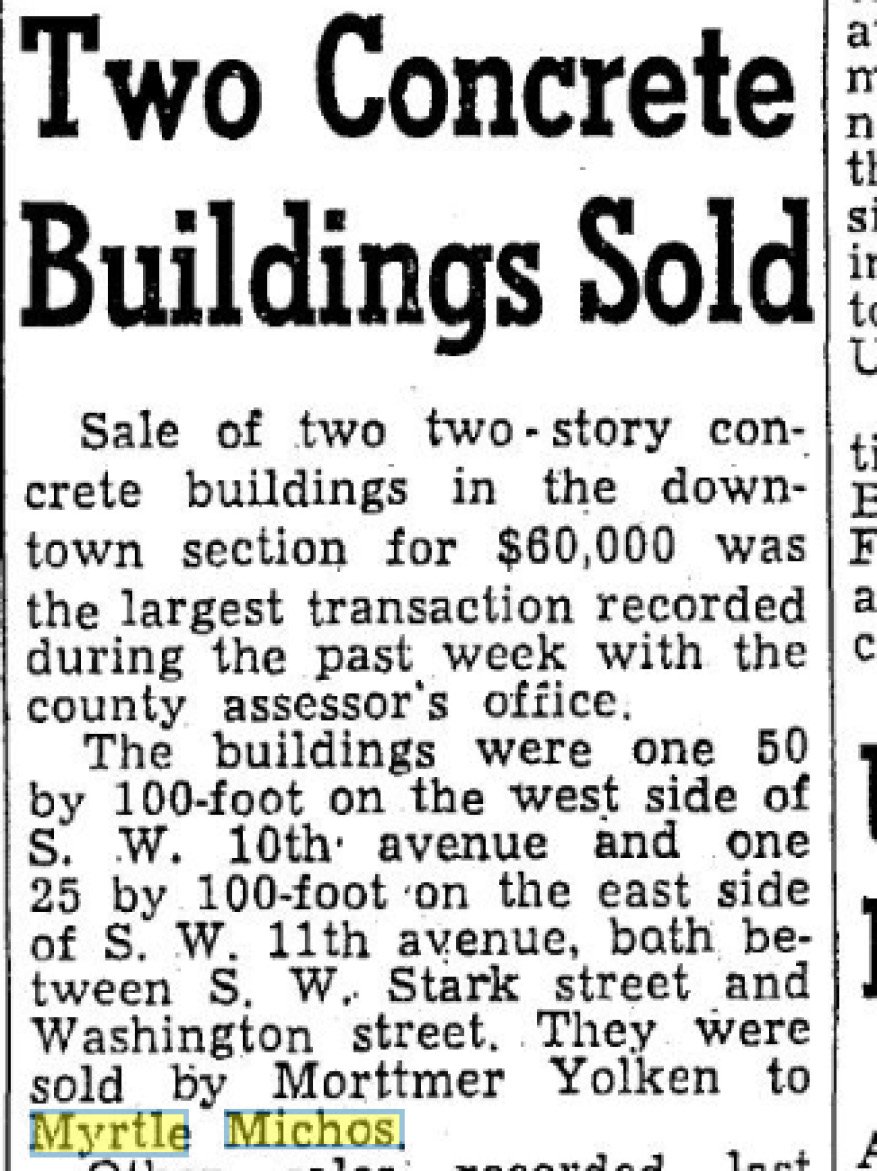
The building as stated in the Oregonian article dated December 24, 1950, page 11. It appears that is the building that housed the Music Hall amongst others and was from 10th to 11th streets.
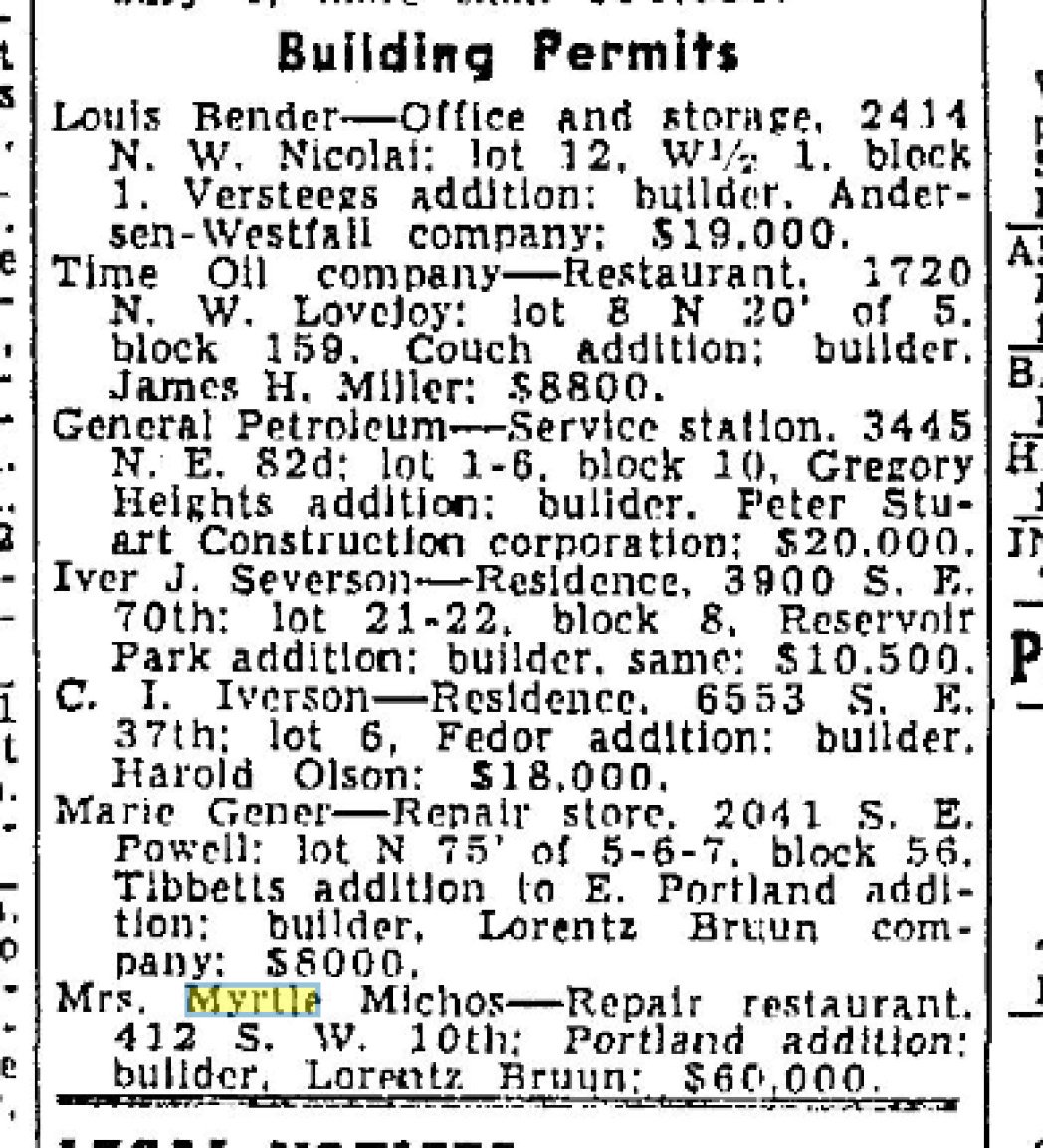
A building permit was pulled at a value of $60,000 for the Terrace per the Oregonian January 20, 1951, page 18.
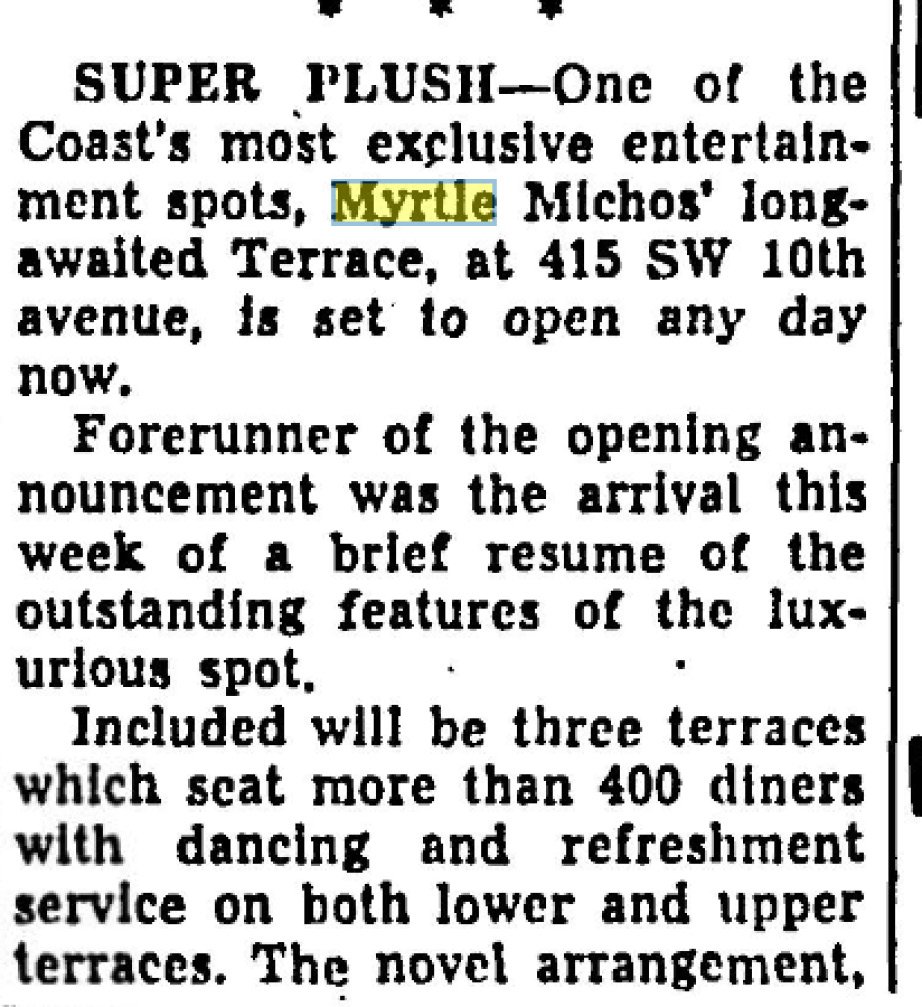
This announcement in the Oregon Journal March 22, 1951 page 39, “...is set to open any day now.”

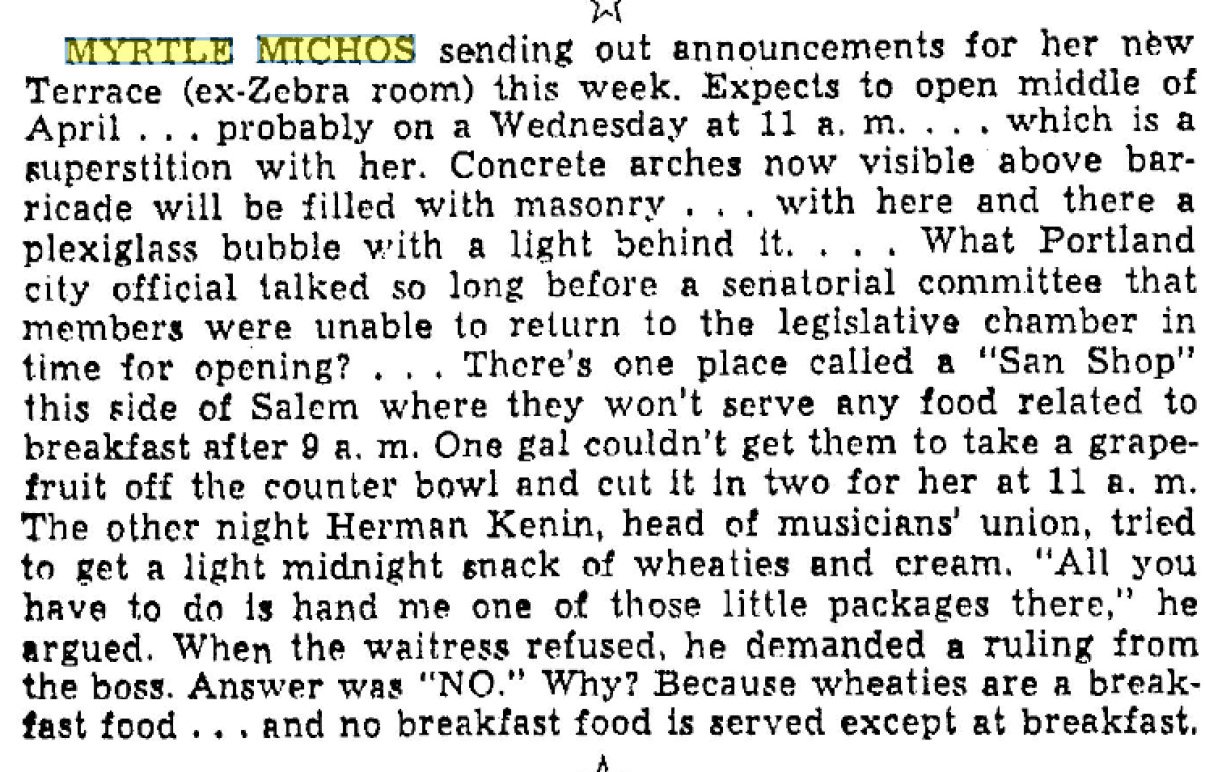
It appears that per an article in the Oregonian March 19, 1951, page 18 the Terrace in the Zebra Room space, not the Music Hall was going to become a reality.
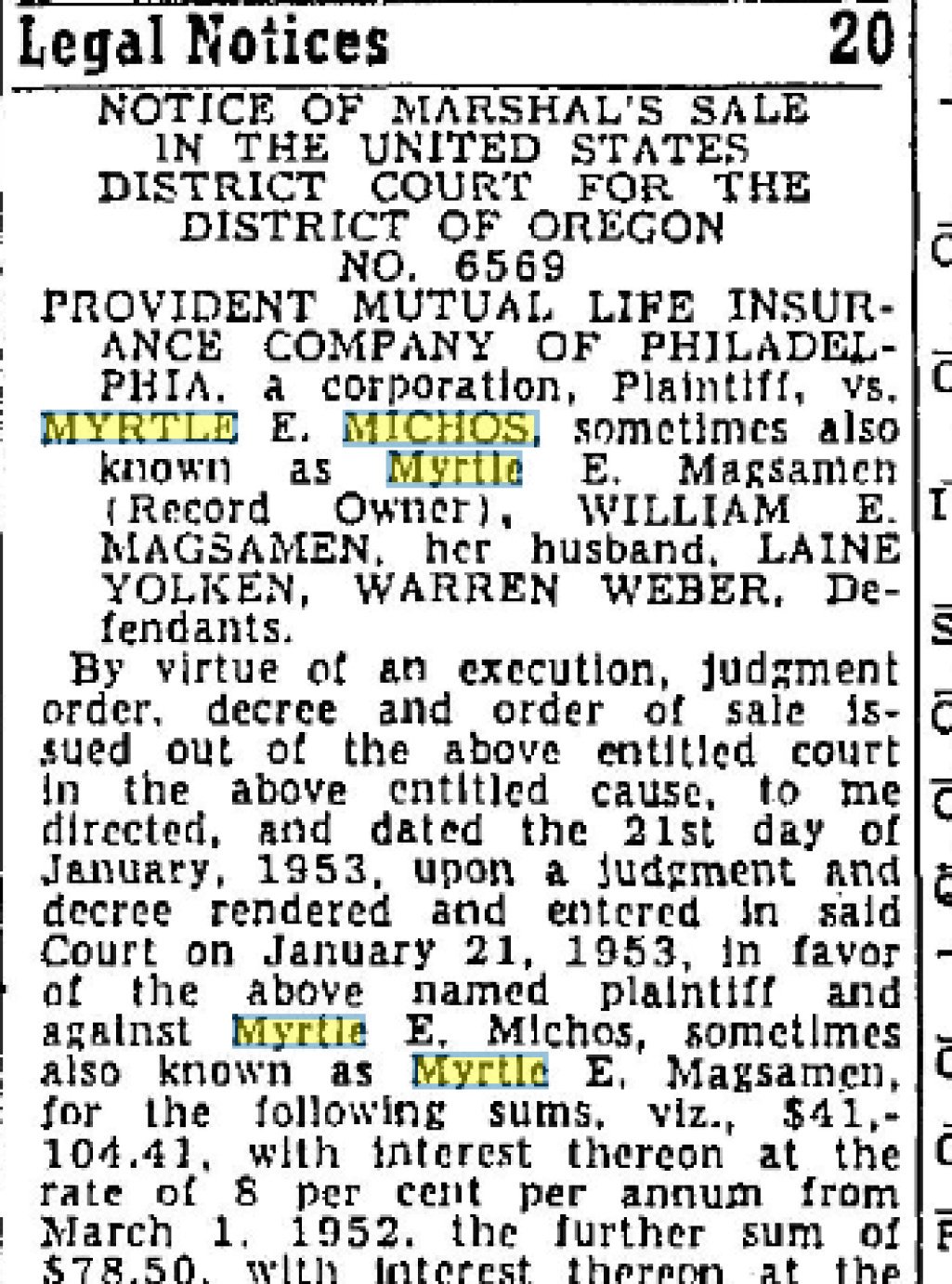
This is the last mention of the ‘anticipated’ opening of The Terrace. No advertisements in the Oregonian or Oregon Journal. From 1951 until 1961 there is no record of occupancy – will continue to research. By 1953 Myrtle Michos’ name appeared in the paper again, but not favorably per the Legal Notices section in the Oregonian February 14, 1953, Page 17.
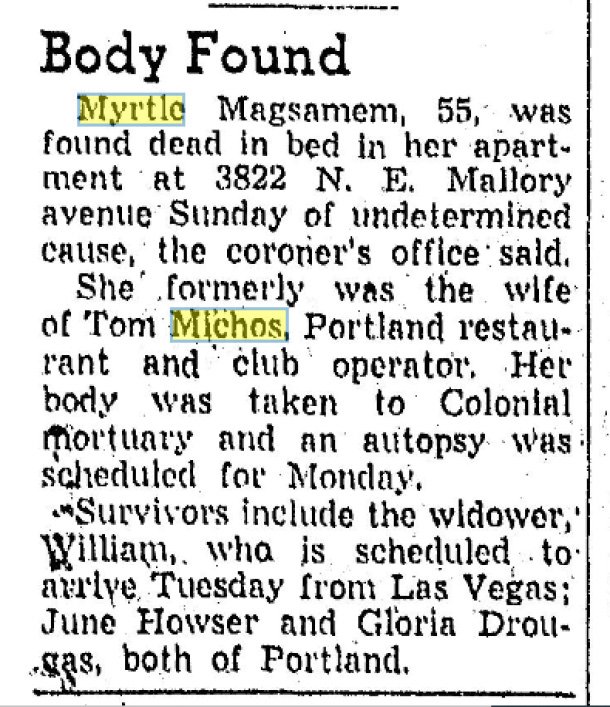
The next time Myrtle’s name appears the press is about her death as stated in the Oregonian January 11, 1955, page 9.
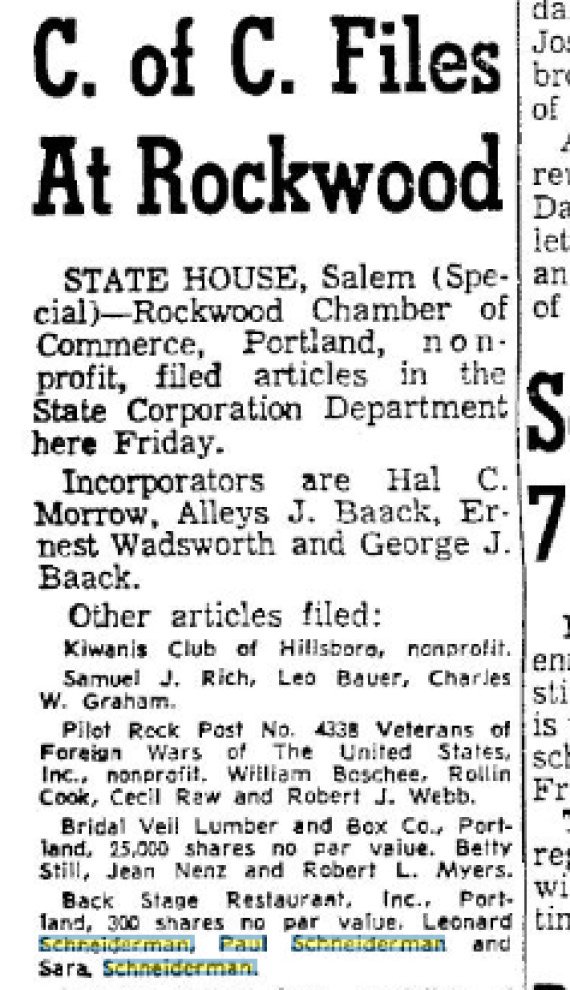
There has been mention of the Back Stage Bar. At this time no newspaper mentions, except one, the Oregonian in October 4, 1958, published on page 30 the sale of stock of Back Stage Restaurant Inc. citing Paul, Leonard and Sara.

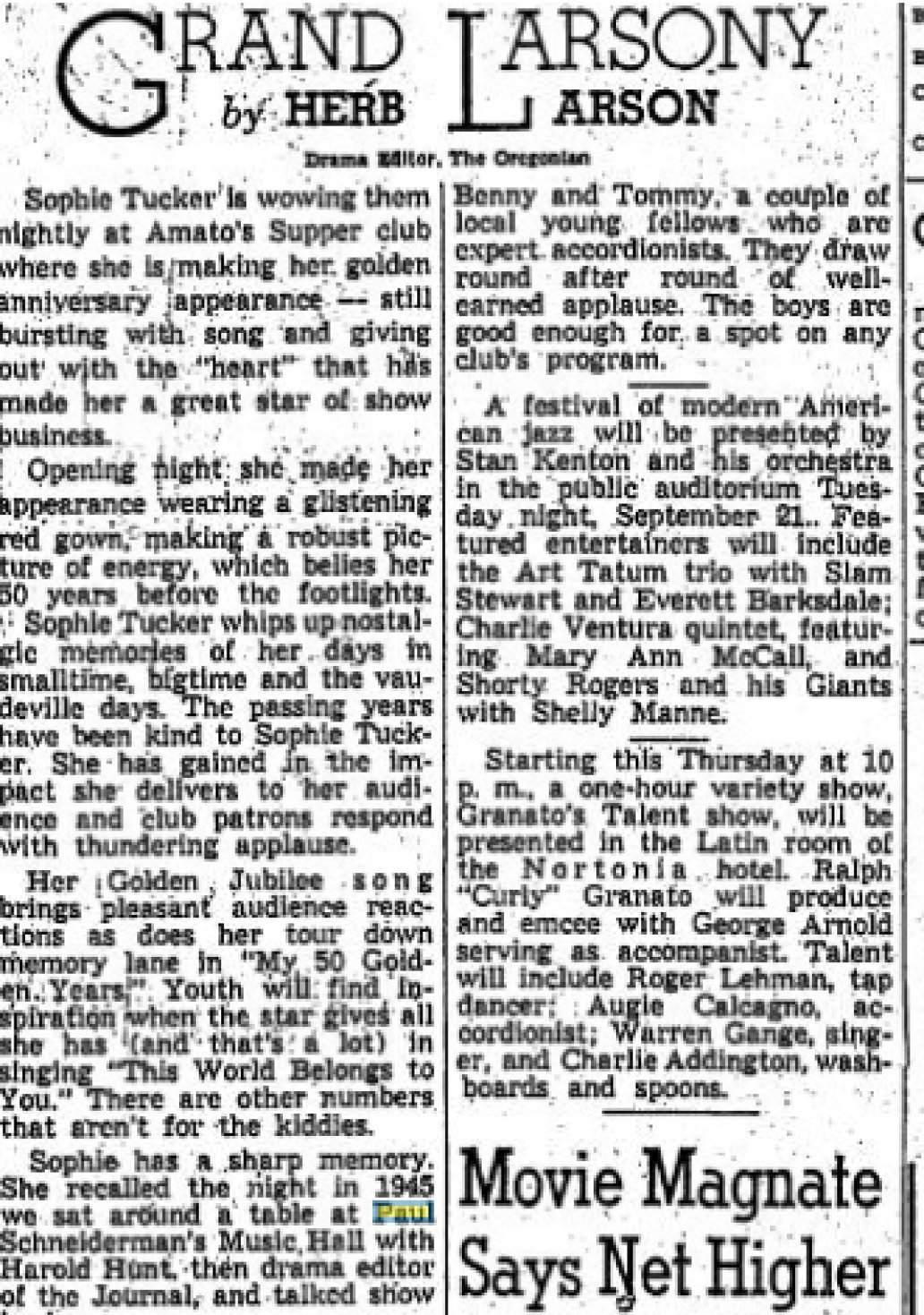
Sophie Tucker returned to Portland appearing at Amato’s Supper Club – Sophie reminisced about the Music Hall in an Oregonian article September 16, 1954, page 17.
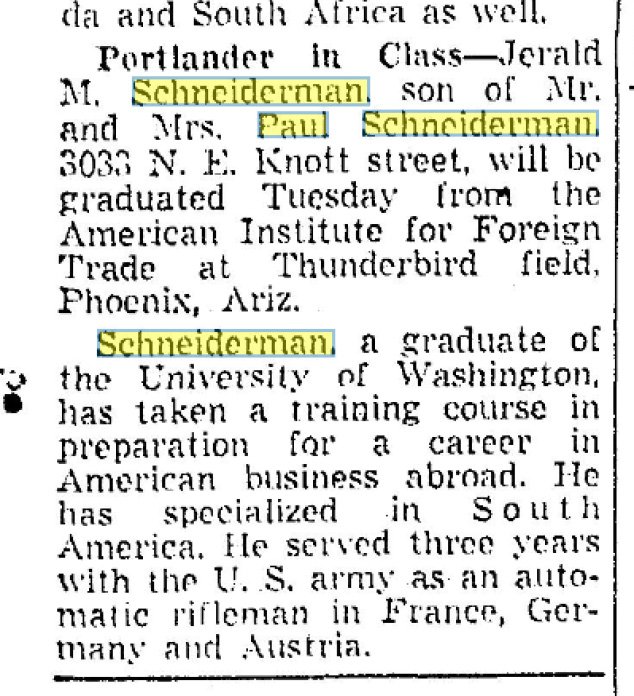
The next mention of Paul Schneiderman was in the Oregonian January 25, 1954, page 11 where Paul’s son was graduating
![And for Leonard [Paul is mentioned as well], in the Oregonian June 20, 1968, page 43 about the birth of his grandchild.](https://images.squarespace-cdn.com/content/v1/6324fa1d5d2c5f1d7acfce0f/9963e27c-0523-48eb-a658-01a991af8d91/All+Venues_Page_048_Image_0002.jpg)
And for Leonard [Paul is mentioned as well], in the Oregonian June 20, 1968, page 43 about the birth of his grandchild.
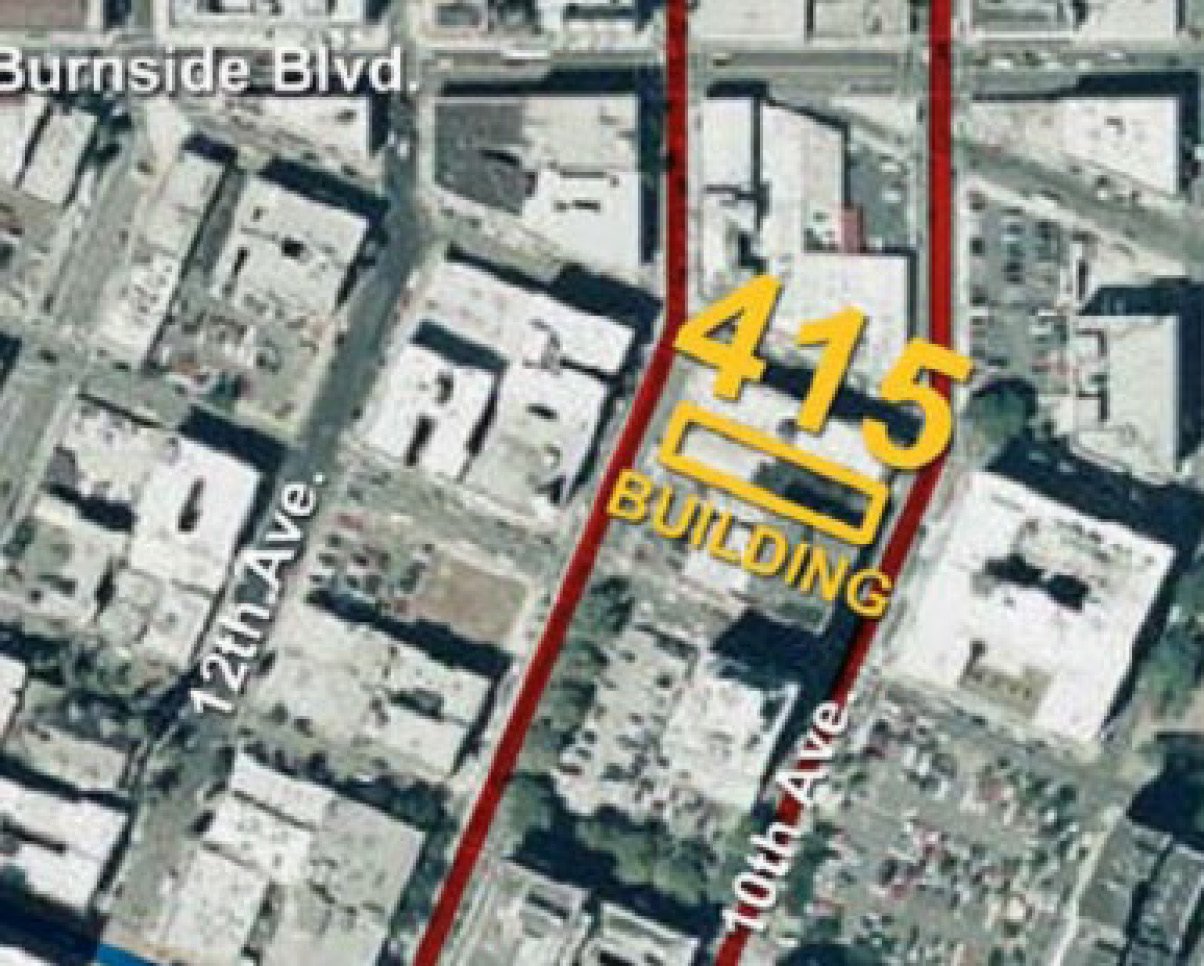
1962 Building torn down and a new building is constructed called the 415 building or later called The Checkerboard Building.

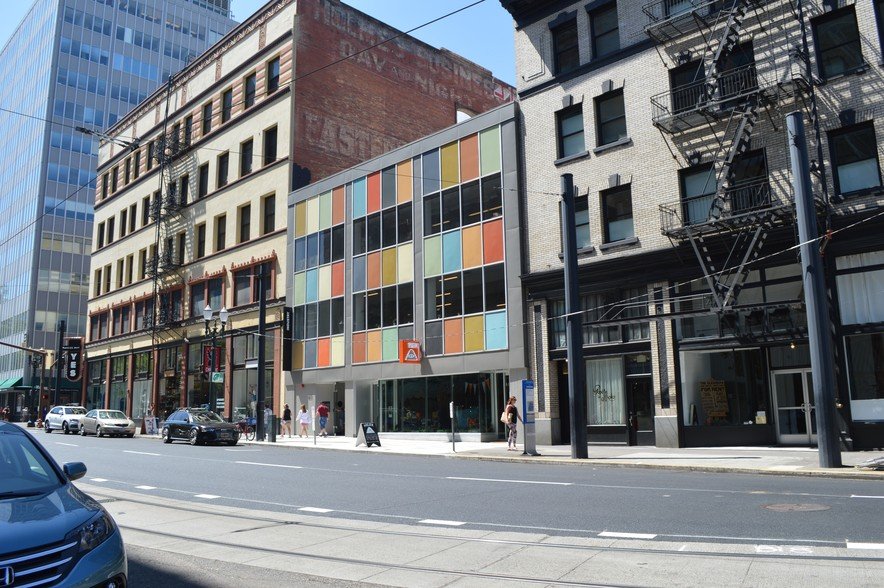
View from 10th
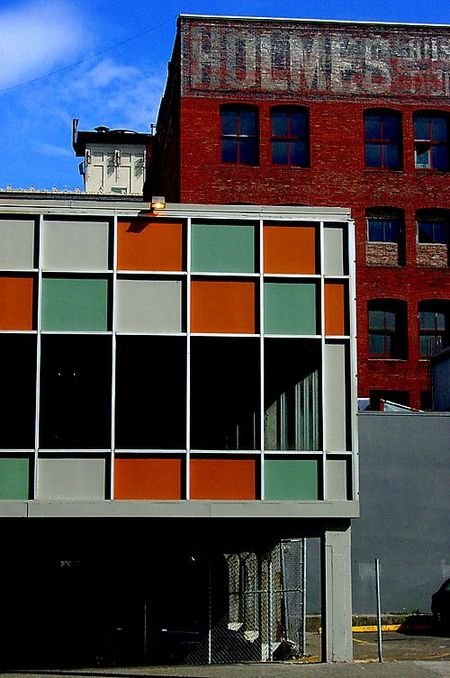
View of building SW 11th.

2008 Save The Checkerboard Building!!! - Blogtown - Portland Mercury https://www.portlandmercury.com/BlogtownPDX/archives/2008/07/01/save-the-checkerboard-building 2011, https://chatterbox.typepad.com/portlandarchitecture/2011/11/time-based-architecture-pica-to-occupy-checkerboard-building-downtown.html Located at 413 SW 10th Ave. in Portland, Oregon, the Poler Flagship store is HQ for all things #campvibes. We're open 11-7 Monday through Saturday and 11-6 on Sunday. Next time you're in town stop by and say hi. Per website; https://poler.com/pages/flagship-store-1
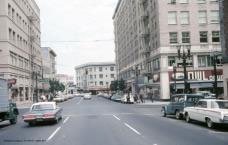
The Music Hall around the corner from the Clyde Hotel which was on Stark Street. During the 1980s was home for CC Slaughters. Across the street was another bar at the Fish Grotto – Boxxes, Brig, Panorama, Red Star Garage. Looking at the photo, The Music Hall building is on the left side, a short two-story building between to taller buildings. At the end of the street, the three-story building is where the Riptide was.
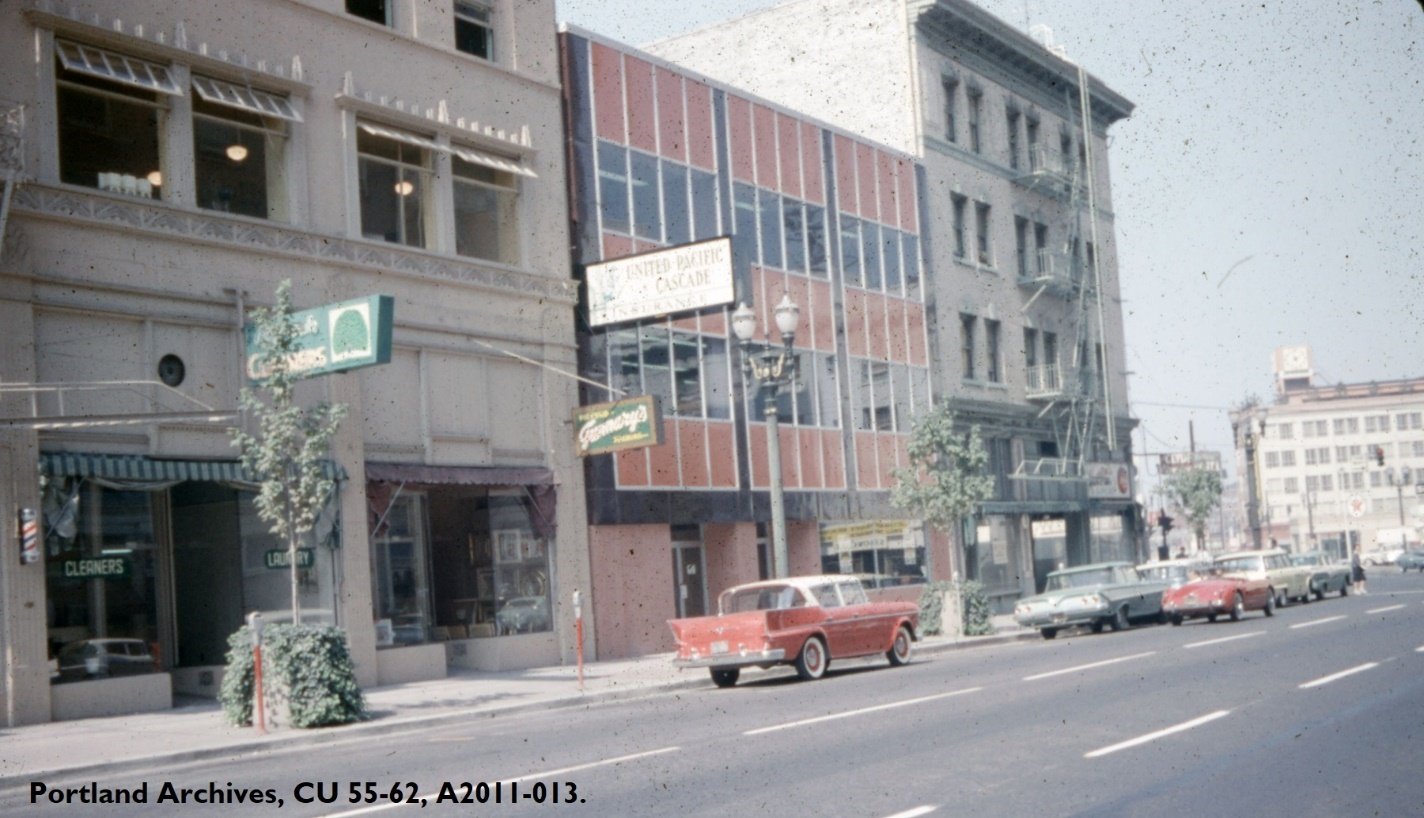
Efiles - CU 55-62: SW 10th Ave, near SW Stark St (APF/3975) (portlandoregon.gov) Efiles - VZ 191-67: 949 SW Stark near SW 10th (APF/10399) (portlandoregon.gov) from Mary Hansen
Per Donald Horn doing research, “As a historian, I find it hard to believe that the city of Portland and the mayor’s office did not know what was going on during the time female impersonators were performing at the Music Hall. With all the press and ads as well as the longevity of the places it seems odd to me that it ‘all came to a head’ in early 1950.
Another note, the address of 413, 413 ½ and 415 is hard to distinguish along with adding SW 10th and Stark. However, I have tried my best to unravel and figure out who or what was where at any given time period.”
Per GLPAN
The Music Hall billed a very popular trio, the Mills Brothers (see The Oregonian, Jan. 22, 1950, p. 10), for a run of performances and, instead of omitting the drag shows, included them on the bill. Among those paying to see the Mills Brothers were City Council members, who were offended by the inclusion of drags. Upon investigation, it was discovered that both the Music Hall and the Backstage were being run on the same liquor license. Council closed both places, and neither ever re-opened.
Per https://pdxscholar.library.pdx.edu/cgi/viewcontent.cgi?article=3978&context=open_access_etds
Cross-dressing Performers at Music Hall (oregonhistoryproject.org) https://www.oregonhistoryproject.org/articles/historical-records/cross-dressing-performers-at-music-hall/
“[Dorothy McCullough] Lee's increased action against gay bars were part of her reformist attack on vice throughout the city, rather than a direct manipulation of elections or distraction from scandal. Gay bars during Lee's administration included the Harbor Club, Music Hall, Back Stage, and Rathskellar Beer Parlor. A lesbian clientele gathered at the Buick Cafe, while a mixed crowd went to the Back Stage and Music Hall.
In addition, “In 1950, the Music Hall's renewal application drew OLCC and council scrutiny. The Music Hall was a popular Portland drag club, offering nightly live acts. As Joan Scott points out, the prevalent depiction of queers in the 1950s as "isolated perverts" did not negate the existence of large gathering locations that were not well-known by non-queer people. Both the Music Hall and Backstage, connected to the back of the Music Hall, were usually "jammed with customers," remembered customer Duane Frye. While the Hall probably also drew curious non-queers, queer customers in Portland were more aware of the Music Hall than non-queer politicians and citizens. Writer William Holman explains that the Music Hall and Backstage were "widely known to 'that percentage in the know." The meaning of "in the know" depends on context, since gay bars and drag shows nationally drew both queer and non-queer customers. In addition, “According to historian Tom Cook and Music Hall customers, council efforts to close the Music Hall began when councilors went to see the Mills Brothers, a mainstream music act, at the Music Hall in 1950 and were "appalled" by an opening drag act. However, the police had issued earlier reports on lesbians at the Music Hall. The women's protective division responded to complaints about "the suggestive and disgusting nature of entertainment at the Music Hall" in 1949. Division supervisors instructed female officers, escorted by a male officer, to verify reports that lesbians "were operating" at the Music Hall and Buick Cafe "in the attempt to pick up women and make lovers of them." The officers reported that they successfully observed lesbians and lewd behavior. They gave detailed reports on entertainment at the Music Hall, highlighting cross-dressing and "a smutty line of patter" in songs and introductions. Although the Music Hall had operated since 1937 without comment from OLCC or the city council, the council debated owner Leonard Schneiderman's request for a 1950 liquor license renewal at length. Schneiderman operated the Music Hall, Zebra Room, and Back Stage under one liquor license. He was first cited by the OLCC in January 1950, for unsatisfactory provision of meals. OLCC then rejected his 1950 renewal application based on unsatisfactory past operations, inadequate food, and it failing to be "in the best interests of the public" to permit a single license for all three of his establishments. Schneiderman applied for a hearing and OLCC agreed to consider an application for the Music Hall alone, provided that the city council gave him a favorable endorsement. OLCC also required that Schneiderman prohibit "lewd and indecent entertainment", particularly male and female impersonation. Historian George Chauncey argues that liquor license requirements that gay bars be "orderly" were highly influential in efforts to close gay bars. In New York, the state liquor authority considered the simple presence of queer customers disorderly. OLCC seemed to uphold this interpretation by including discouragement of queer customers as a requirement for the Music Hall's license renewal. Evaluating Schneiderman's request, city councilors criticized female impersonation acts and the Music Hall's queer clientele.
“Schneiderman promised that impersonation would no longer be permitted at the Music Hall. The council made renewal of his license contingent on prohibiting future impersonation and lewd entertainment, serving more food, and discouraging queer patrons.” per Gay Bars, Vice, and Reform in Portland, 1948-1965 Beka Smith, Portland State University
Per GLAPN website: One of the highlights of Portland’s gay and lesbian history is a visit to this wonderful building where, in the late 1940s, following World War II, many of the city’s gay men and lesbians came for entertainment and socializing. Opened by Paul Schneiderman in 1937, the nightclub took its name from the tradition of the old English musical hall. Its first mention in the Oregonian is in an article stating it was denied a liquor license, Mar. 13, 1937, p. 12. Early on, it featured vaudeville-type entertainment as well as big name acts. https://lostwomynsspace.blogspot.com/2014/03/the-buick-cafe.html
At some point (around 1947, we believe), Paul’s son Leonard booked a San Francisco female impersonator troupe, and the rest is history. The nightclub soon blossomed with a lively mixed lesbian and gay crowd that howled with laughter at the double entendre and risqué innuendo of its entertainers.
Per Appendix II – Historical Highlights/ Burnside Triangle Walking Tour September 2002 the Music Hall is listed as follows:
19) The Music Hall, 413 SW 10th
• Opened in 1937 by Russian Jewish emigrant Paul Schneiderman, the hall originally showcased vaudeville acts.
• Around 1947, Paul’s son Leonard booked a San Francisco female impersonator troupe. It quickly became one of the city’s most popular gay and lesbian nightclubs featuring both male and female drag performances and musical acts.
• Since the late 1940s and early 1950s was an era that pre-dated canned music and lip-synching, the drag performers sang their own songs.
• Notes from a February 1949 Vice Report (Women’s Protection Division) on the music hall:
“The Master of Ceremonies appeared to be a man; but later in the evening announced she was a woman.”
“Sgt. Warren of the Detectives said we would probably have to go there several times until we were better known before, we would be accosted.”
“The most vulgar part of the show was a take-off on Mae West, which was done by one of the impersonators and this act was the so-called highlight of the entire performance. The dirty stories were told in a very suggestive tone of voice and facial expressions [sic].”
